#highly recommend! it's great!!! it's also super readable!
Text
Okay but I did finish the first Worlds Beyond Number episode and immediately picked up The Infinite Playground again and I do think anyone doing anything creative, anyone involved in a hobby- or fun-based community (like fandom!), and anyone who likes games of any sort or game-based media should check out this book.
#in this chapter we have discussed: openness to play as an adult. play regarding death and dying. altering rules (cheating!) to create fun.#highly recommend! it's great!!! it's also super readable!#cuz one would hope an academic writing about play and fun could make reading fun!!!#megs is reading#like genuinely i do love love love actual play as a genre because it really does SO much to encourage play!#anyway I'm gonna see how far i get before the episode bye#sorry not to be a fucking dweeb nerd about it BUT ALSO#read the book i beg of you it's not even long either
34 notes
·
View notes
Text
why i write in obsidian.md (and why you should try it!)
hey, hi, have I mentioned my notes app? let me tell you about my notes app! I’ve been writing in obsidian for over a year now, for fanfic and original fiction/worldbuilding (and dungeons and dragons, and life organisation, and a myriad of other things) and so far I’ve gotten at least three people to also start using it, and I am in fact on an endless quest to get more people to try it.
obsidian.md how do i love thee, let me list the ways:
It’s offline. you are not beholden to the whims of wifi!
Did i mention it’s free? it’s free!
you can pay to support the devs, or to access the sync service, but honestly I just use a free file sync service to move things between my desktop/laptop.
It’s super lightweight at its core. you can (and I do) run it with a bunch of plugins and customisation, but at it’s base it’s just text, in simple files. plaintext. readable by anything. your writing is not trapped in proprietary file formats.
HOWEVER you can in fact customise every aspect of it and if you like Making Your Notes Cute I cannot recommend it enough as a Way To Procrastinate Actually Writing
Crucially, you can link your notes. This is phenomenal for not only worldbuilding, but planning, research, outlining and connecting characters and events. You just make a note, type in square brackets, and boom. linked notes. You can make yourself a little writing wikipedia with approximately 0 effort.
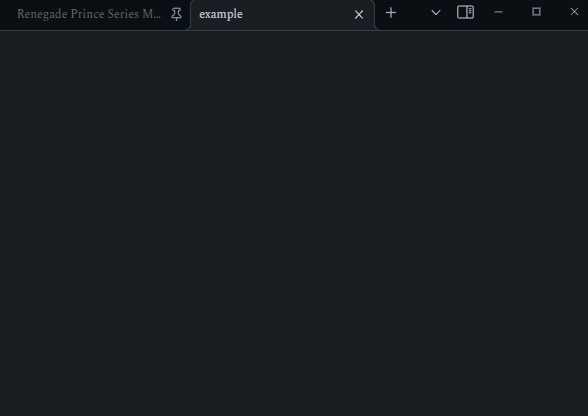
I have separate vaults (Instances, pretty much. Big overarching folders with separate sets of content) for my Valloroth project, my day-to-day notes/fanfic, and my D&D game. They’re aesthetically very different, which is so so so great for getting in the right headspace for the work I’m doing.
OH and we have obsidian canvas now! which is a simple mind-mapping feature where you can make and connect note cards, which can also be notes in your vault. I haven’t had a chance to do timelines with it yet, but it’ll be fun for that. I have made relationship charts with it, and it was great for that. If you like visually laying out boxes of information and connecting them into a pepe silvia board of plot, canvas is incredible

this is a pointcrawl map I made for my D&D game. Those red words in the boxes? links to the locations in the city the players were exploring. phenomenal
do you like split screen? you can have multiple notes open at once in horizontal and vertical configurations, and you can also open multiple tabs in each split window. it’s SO great for research and outlining, when you need like ten documents open at once to move between

finally, there are so many addons to COMPLETELY CUSTOMISE your Writing Setup. styling for tags. kanban boards. LINKABLE MAPS. ways to label scenes with metadata and pull just so many different tables/lists of story information. AND SO MANY MORE. I’m gonna do a whole post of my favourite writing plugins at some point so i can yell about them
the only downsides are that it’s somewhat clunky still to export things out of obsidian—I copy my fics into googledocs for my beta, and I have a plugin to make exporting to html easier to post on ao3, but it’s still kinda fiddly. Also, if you want a program that Has Everything and Just Works, this is…not that. you can build a lot of really useful writing specific features, but you do have to build them. it’s a sandbox, so if you don’t like sandbox-style programs, this may not work for you.
that being said, I do think everyone should try it and play with it and love it like I do and convince all their friends to start using it like i did. come play with obsidian with me! it’s fun! there’s a great community in the official discord that’s very active, plus an ever-growing collection of resources, particularly on youtube (highly reccommend Danny Hatcher’s videos as a jumping in point, they’re super accessible imo)
anyway, come try obsidian!
#obsidian md#obsidian.md#writeblr#writing program#writing#writing process#notes app#space has thoughts#writing apps#writing tools#writer things#writing setup#this whole blog has just been a long con to get more people to download obsidian#notes app (beloved)
777 notes
·
View notes
Text
The Weird And Interesting Existence of Japanese Manga Magazines
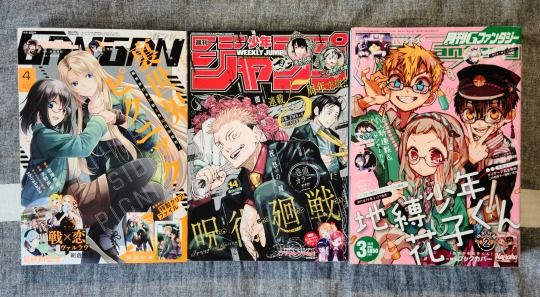
I don't exactly have 30,000 different magazine issues across countless publishers and demographics, but I do have a few (because they have some of my favorite series on the covers), and flipping through them they're all very different to one another, and interesting in their own ways, so I wanted to show just how different, unique, and even at times worth it, these magazines are to NA readers.
⚠️Warning: Minor/Mild Spoilers for Jujutsu Kaisen, Otherside Picnic, and Toilet-Bound Hanako-Kun⚠️
I'm going to break it down by magazine, and I'm going to go left to right from the above image. I'll be talking about bonuses, pricing, quality, content, and a few other observations throughout these three magazines.
Monthly Shounen Gangan
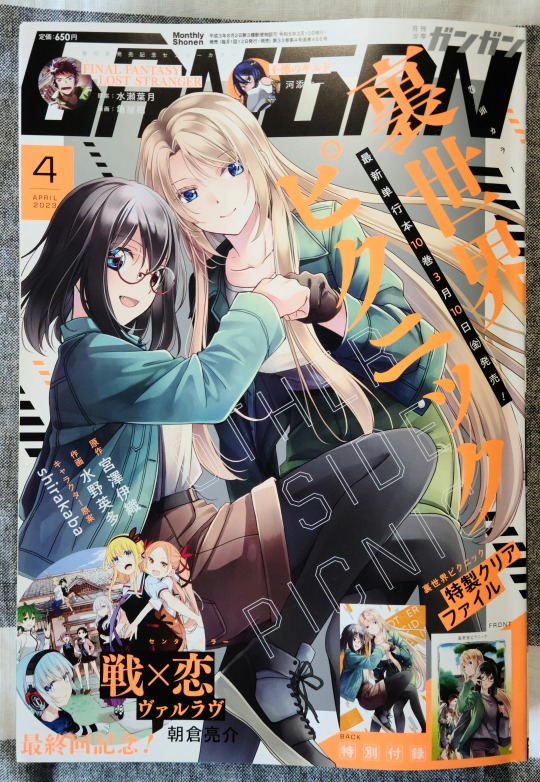
Unsurprisingly, the monthly magazine is better quality than the weekly one. Monthly Shounen Gangan is a monthly shounen manga magazine under Square Enix and carries titles such as: Otherside Picnic (manga adaptation of the LN, and the cover of the issue), Daemons of The Shadow Realm, Final Fantasy: Lost Stanger, and a few others. I wouldn't call it a "packed" magazine per se, but it's definitely got a list of recognizable titles to it.
Anyways, getting into the numbers of this magazine, they're as follows:
Cost -> 650Yen
Number of Chapters -> 21
Number of Bonuses -> 1
Build / Print Quality -> 6/10
Number of Color Pages -> 4
So, only one bonus, but I think it's a pretty solid one, as it's an Otherside Picnic clearfile. Not exactly a super decorative or functional bonus, but I really like the art on it so I'm happy with it.
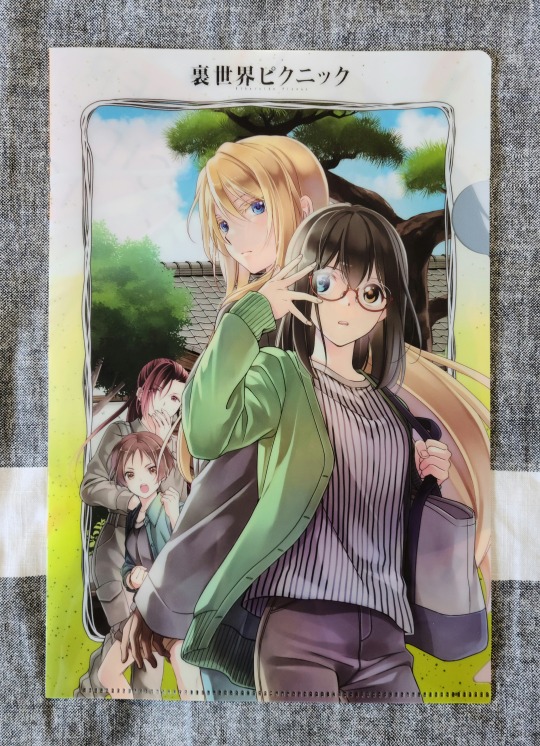
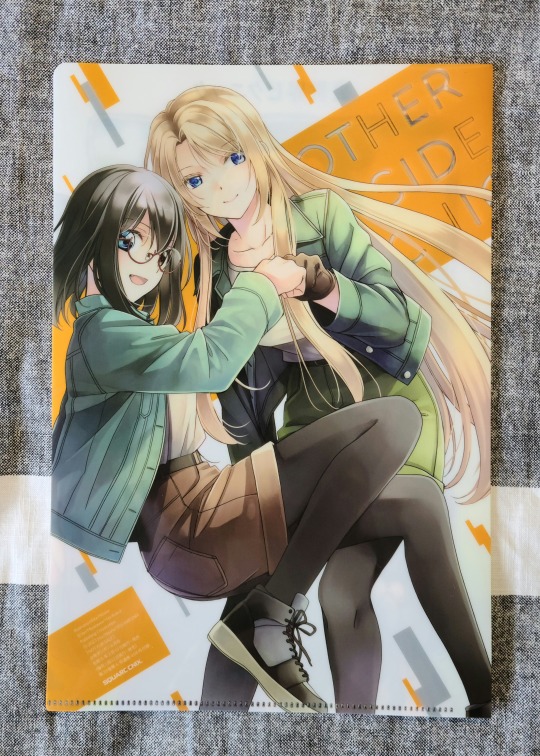
Anyways, into some more detailed information about the magazine issue. The paper itself is very smooth, though it's quite literally paper thin. You won't have any real issues with it, but in lighter or blank areas on the page you can very easily see through to the next page. Similarly, the quality of the ink is pretty hit and miss. Lighter and more gray colors are preserved and displayed quite well, but anything close to or right at black is very spotty and grainy. It even shows in the black used for the panels. I don't think it's something that will really get in the way of reading the issue (if you want to do that), but I also wouldn't say it's all that great.
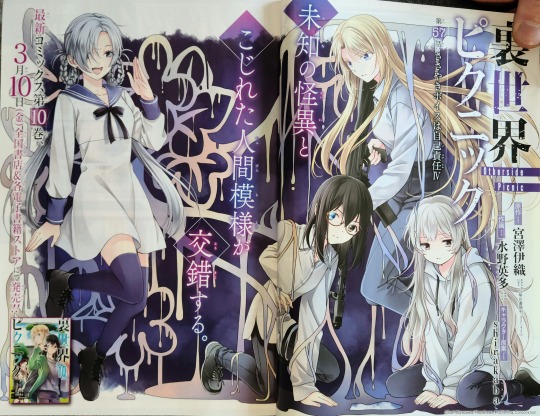
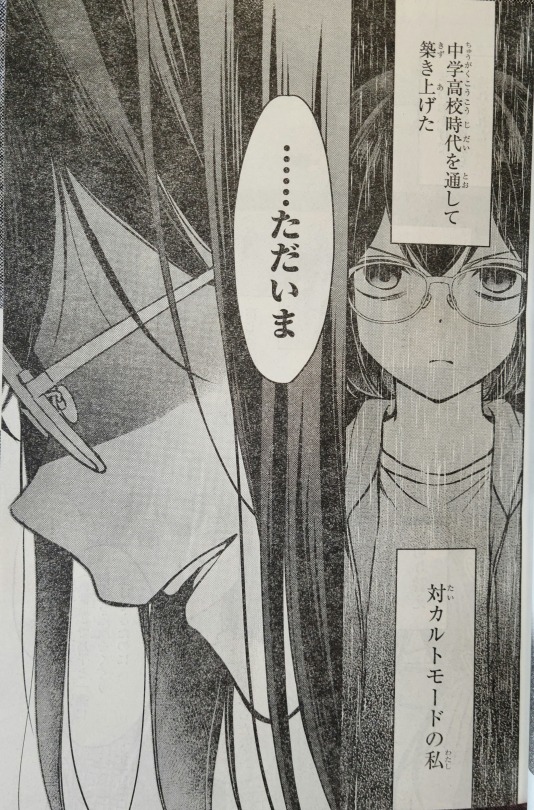
Weekly Shounen Jump
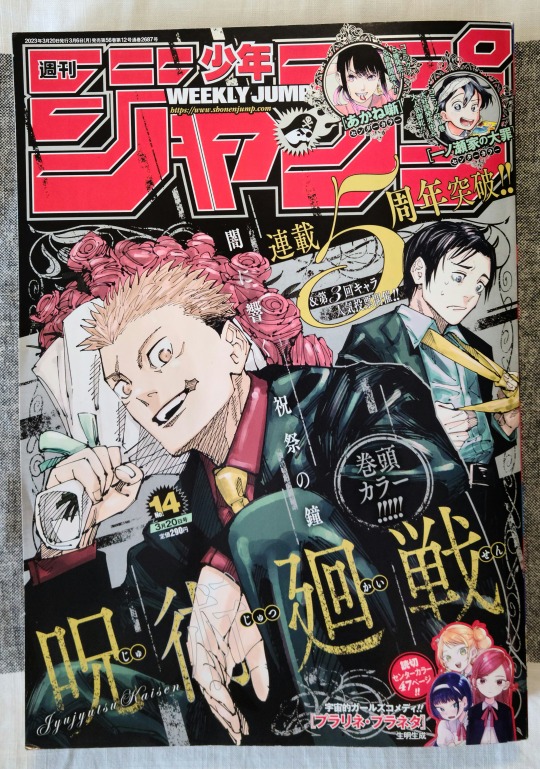
Weekly Shounen Jump from Shueisha is arguably the biggest/most popular magazine for manga. It's got to be accessible, it's got to be quick and it's got to be highly available. Carrying manga monsters like: Jujutsu Kaisen, Sakamoto Days, My Hero Academia, Black Clover, and countless more titles. But does it hold up?
Well, these numbers/thoughts speak to that ability.
Cost -> 290Yen
Number of Chapters -> 19
Number of Bonuses -> 0
Build / Print Quality -> 3.5/10
Number of Color Pages -> 4
So, there you have it. Dirt cheap and highly available magazines require the lowest of standards to get out there. Now, a 3.5/10 might seem a little low, but trust me when I say that this thing is barely readable. The inking is as light as possible to save a Yen or two where they can, and the pages themselves are colored, and they're not even all the same color. It's absolutely something I wouldn't recommend trying to read from period, even if it's less than $3 USD. In reality, for a North American/English reader base, this is a collectable item purely for the covers/color pages.
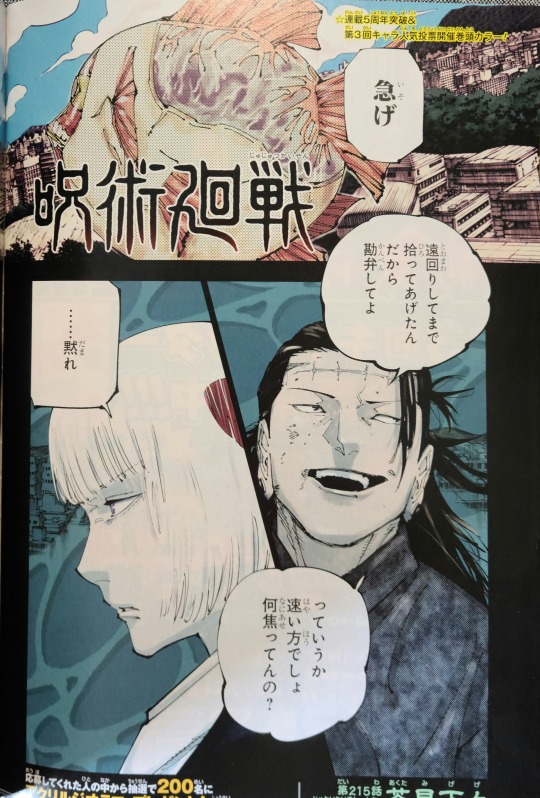
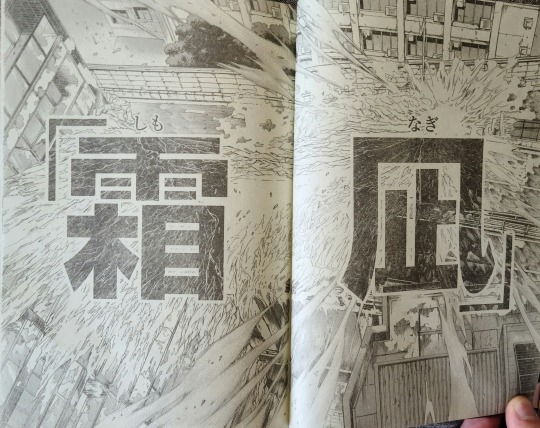
Yeah, I know this page isn't really a great example of the issues with the inking and page colors, but it's one of the few pages from the JJK chapter that isn't a massive spoiler for readers. Instead, take a look at this view of the open end of the magazine.
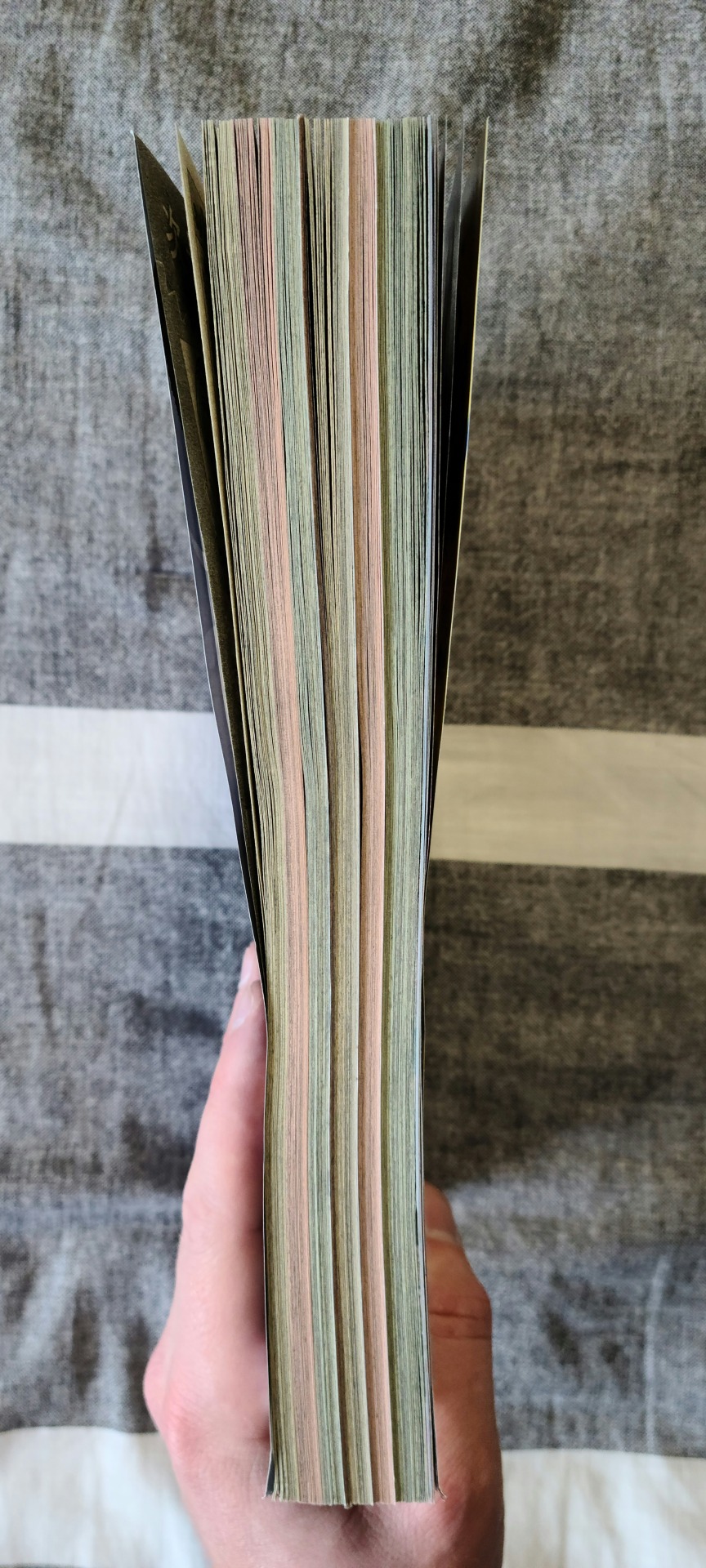
Monthly G-Fantasy
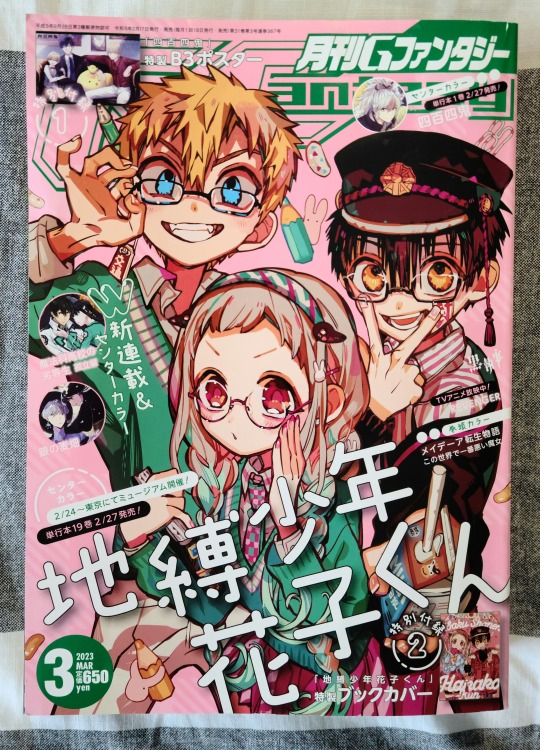
And last, but certainly not least, we've got another magazine from Square Enix: Monthly G-Fantasy. Interestingly enough, this magazine started off as a special issue of Monthly Shounen Gangan all the way back in 1992, but found its way into a fully fledged magazine of its own, sporting popular titles like Hanako-Kun, and well, a lot of titles that I don't really know that much about. Anyways, how does this second helping from Square Enix match up against its progenitor?
Cost -> 650Yen
Number of Chapters -> 22
Number of Bonuses -> 2
Build / Print Quality -> 8.5/10
Number of Color Pages -> 5
A quick interlude to show off the bonuses. You get a (one-sided) poster, and a really cool special edition dust jacket for Hanako-kun (that you have to cut out). Really awesome pieces to add to the issue.
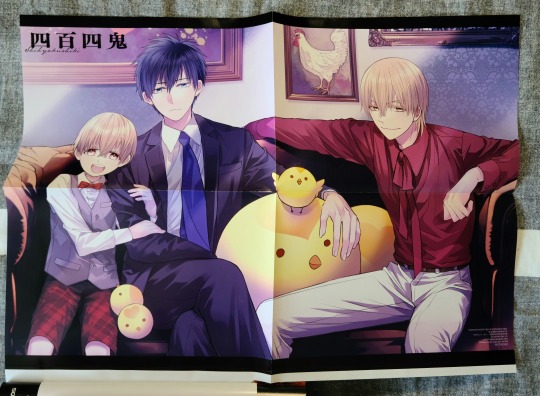
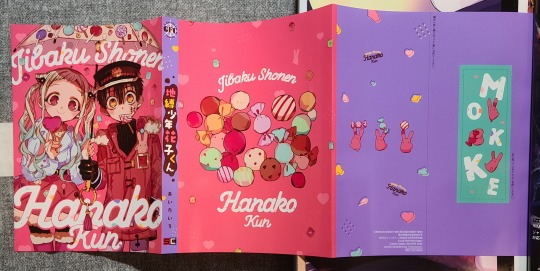
Yeah, I didn't really expect it either. G-Fantasy knocks it out of the park as a magazine, especially at its price point when compared to Shounen Gangan. The paper quality itself is pretty comparable, as both are somewhat thin yet very smooth, but the ink quality for G-Fantasy is just way ahead of Gangan. Really, if it's not better than a lot of Viz manga in terms of ink quality, it's at the very least on par with it. Wholeheartedly, I'd say that it's a better read than most modern regular sized viz manga. Massive trim size with nice paper and lovely ink quality, there's not a whole lot to complain about when you think about it being around half the price of a viz volume for such a large amount of content. So yeah, if you like Hanako-Kun, and potentially some of the other titles in here, and you want to work on your Japanese (and like bonus stuff), there's not really a big reason or limiter in keeping up with G-Fantasy.
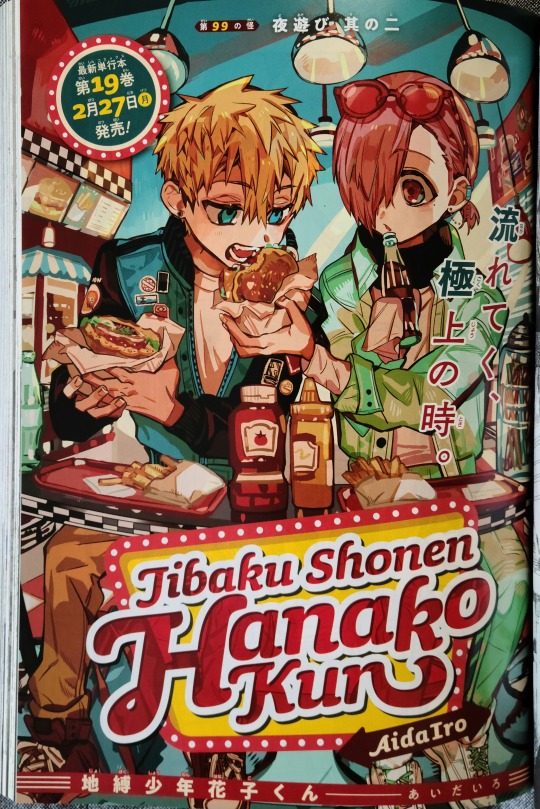
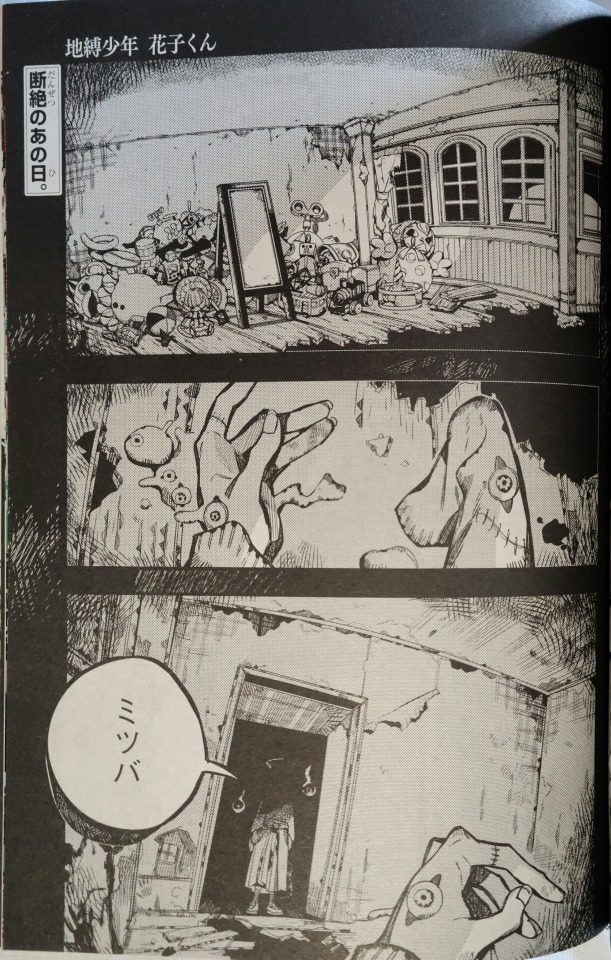
And just a bit of a closing statement/final remark on these magazines. Alongside the chapters, the advertisements and information within were all super interesting. They were sorta all over the place, ranging from ads for pop up shops or merchandise to character information and statements to all sorts of polls and opinion panels. It's a really interesting look into how the culture surrounding manga works in Japan.
So, at the end of the day I definitely think that the monthly magazines are more likely to be worth it for NA readers, but if you're a collector and want to have a cover for your favorite series, I wouldn't really say it's a waste of money at the end of the day.
#jujutsu kaisen#呪術廻戦#toilet bound hanako kun#jibaku shounen hanako kun#jibaku shonen hanako kun#地縛少年花子くん#otherside picnic#urasekai picnic#裏世界ピクニック#manga magazine#weekly shounen jump#weekly shonen jump#monthly shounen gangan#monthly shonen gangan#monthly G-Fantasy#anime and manga#manga
19 notes
·
View notes
Note
book asks: 3, 6, 10, 11, 20
3. What were your top five books of the year?
Red X by David Demchuk - this was the first book I read this year and it's stuck with me this WHOLE time. It's a tough book to describe succinctly - it's a supernatural horror novel fictionalizing the events surrounding the very real disappearances of men in Toronto's gay village between the 70s and the 00s, but interspersed with non-fiction essays by the author. The relationship between queerness and horror is one that's fascinating to me and Demchuk really tears into it here. Cannot recommend it highly enough, though I'd check storygraph for triggers if you're a sensitive reader.
Our Wives Under the Sea by Julia Armfield - one part moody, existential relationship novel, one part Lovecraftian body horror. It's gorgeously written, bracingly sad, and the dread is smothering. Very atmospheric and contemplative, while still maintaining a sense of urgency.
Even Though I Knew the End by C. L. Polk - this was so much fun. It combines a few things I love - a good noir detective story, some urban fantasy, lesbians. It follows a supernatural PI attempting to solve a series of grisly murders in 1940s Chicago - with her life on the line.
The Last Days of Jack Sparks by Jason Arnopp - OKAY TALK ABOUT FUN. I listened to this on audiobook and really recommend the format, actually - the narrator was great. The book is presented as the posthumously published final book of Jack Sparks - think of the shittiest, most miserable VICE-style journalist you can imagine, now have him set out to disprove the existence of the supernatural, only to end up immediately possessed. Sounds good, right? It IS. I'm REALLY stoked to read more Arnopp next year
The Five: The Untold Lives of the Women Killed by Jack the Ripper by Hallie Rubenhold - the only non-fiction in my top 5 this year. This book, as you can probably tell, is a historical biography of the five "canonical" victims of Jack the Ripper. It's less true crime than you'd think - there's very little in the way of grisly details of the crimes. Instead, Rubenhold chooses to focus on putting together as compete as possible a biographical record of each of the women, while helpfully contextualizing the facts of their lives with details of Victorian-era life. The dismal similarities between recent "culture war" rhetoric and the attitudes of Victorian moralists were striking, depressing, and vital to understand. It made this book feel even more timely.
6. Was there anything you meant to read, but never got to?
ooh yeah a bunch. I have a bunch of sequels I mean to read and didn't get to - most notably the last two books of the Foundryside series and A Desolation Called Peace. Also The Thousand Eyes, which is the sequel to The Unspoken Name by AK Larkwood. God, I suck at sequels I'm so bad at reading sequels. I wanna get better. Also I was going to finally read Ghost Story by Peter Straub this month, but I haven't gotten to it. I'll save it for next year, I think.
10. What was your favorite new release of the year?
Our Wives Under the Sea, I think. Really striking.
11. What was your favorite book that has been out for a while, but you just now read?
The most extreme example was probably Dracula which I happened to read like a month before Dracula Daily kicked off lmao. But yeah - I'm not super well read when it comes to pre-1900s fiction. I was surprised by how readable it was. Certainly not without its issues, but it was REALLY fun and now I've unlocked a whole literary canon of Dracula spin-off works. I'm so stoked.
20. What was your most anticipated release? Did it meet your expectations?
So embarrassing but my most anticipated release was Spear Cuts Through Water by Simon Jimenez which I haven't actually read yet. I bought myself a copy for Christmas! I'm gonna read it next year!
end of year book asks
4 notes
·
View notes
Text
New Post has been published on https://kellshaw.com/ive-got-piles-of-worldbuilding-notes-scribbled/

I’ve got piles of worldbuilding notes scribbled across paper notebooks, Scrivener files, and Kanka.io. Now I’ve downloaded Obsidian and will see if I can organise everything in the one place. It was okay when I had one book, but now I’m up to drafting the third, I keep forgetting what color various characters’ eyes are, the dates, what phase the moon should be. Little details like that. I heard that Steven Erikson wrote the Malazan Book of the Fallen without keeping notes—a tremendous feat.
While Obsidian has a fantasy calendar plugin, I need to figure out how to use it better, like embedding dates in notes and having it calculate the ages of characters and things. Kanka.io (a RPG note taking wiki) does this and it’s very handy.
why i write in obsidian.md (and why you should try it!)
hey, hi, have I mentioned my notes app? let me tell you about my notes app! I’ve been writing in obsidian for over a year now, for fanfic and original fiction/worldbuilding (and dungeons and dragons, and life organisation, and a myriad of other things) and so far I’ve gotten at least three people to also start using it, and I am in fact on an endless quest to get more people to try it.
obsidian.md how do i love thee, let me list the ways:
It’s offline. you are not beholden to the whims of wifi!
Did i mention it’s free? it’s free!
you can pay to support the devs, or to access the sync service, but honestly I just use a free file sync service to move things between my desktop/laptop.
It’s super lightweight at its core. you can (and I do) run it with a bunch of plugins and customisation, but at it’s base it’s just text, in simple files. plaintext. readable by anything. your writing is not trapped in proprietary file formats.
HOWEVER you can in fact customise every aspect of it and if you like Making Your Notes Cute I cannot recommend it enough as a Way To Procrastinate Actually Writing
Crucially, you can link your notes. This is phenomenal for not only worldbuilding, but planning, research, outlining and connecting characters and events. You just make a note, type in square brackets, and boom. linked notes. You can make yourself a little writing wikipedia with approximately 0 effort.

I have separate vaults (Instances, pretty much. Big overarching folders with separate sets of content) for my Valloroth project, my day-to-day notes/fanfic, and my D&D game. They’re aesthetically very different, which is so so so great for getting in the right headspace for the work I’m doing.
OH and we have obsidian canvas now! which is a simple mind-mapping feature where you can make and connect note cards, which can also be notes in your vault. I haven’t had a chance to do timelines with it yet, but it’ll be fun for that. I have made relationship charts with it, and it was great for that. If you like visually laying out boxes of information and connecting them into a pepe silvia board of plot, canvas is incredible

this is a pointcrawl map I made for my D&D game. Those red words in the boxes? links to the locations in the city the players were exploring. phenomenal
do you like split screen? you can have multiple notes open at once in horizontal and vertical configurations, and you can also open multiple tabs in each split window. it’s SO great for research and outlining, when you need like ten documents open at once to move between

finally, there are so many addons to COMPLETELY CUSTOMISE your Writing Setup. styling for tags. kanban boards. LINKABLE MAPS. ways to label scenes with metadata and pull just so many different tables/lists of story information. AND SO MANY MORE. I’m gonna do a whole post of my favourite writing plugins at some point so i can yell about them
the only downsides are that it’s somewhat clunky still to export things out of obsidian—I copy my fics into googledocs for my beta, and I have a plugin to make exporting to html easier to post on ao3, but it’s still kinda fiddly. Also, if you want a program that Has Everything and Just Works, this is…not that. you can build a lot of really useful writing specific features, but you do have to build them. it’s a sandbox, so if you don’t like sandbox-style programs, this may not work for you.
that being said, I do think everyone should try it and play with it and love it like I do and convince all their friends to start using it like i did. come play with obsidian with me! it’s fun! there’s a great community in the official discord that’s very active, plus an ever-growing collection of resources, particularly on youtube (highly reccommend Danny Hatcher’s videos as a jumping in point, they’re super accessible imo)
anyway, come try obsidian!
Obsidian – Sharpen your thinking
0 notes
Text
Reviews of Christian Allegorical FANTASY
Note: Christianity is a broad, varied thing. I can only write from my perspective, and it’s hard to describe that perspective to an international audience. Words have different meanings in different countries. But this is what I think about the various Christian allegorical fiction I’ve read, measured by writing quality, allegorical quality, and ability to make me happy. Your perspective may vary.
Chronicles of Narnia, by C.S. Lewis –
Writing: Y’all know this guy is good.
Allegory: Shockingly strong for something with such mass appeal. And deeper than you thought as a kid. Never sidelines the story, because he’s integrated the two so well.
Problems: So, you don’t notice the colonialism, racism, classism, sexism, and mild ableism as a kid. Dude was a white British man during the early and mid 1900s. He does not entirely rise above his culture. Some of the dehumanization of species/cultures that are obvious stand-ins for real world cultures horrified me during my latest reread. And it’s subtle enough that it’s hard to point out to kids.
Story: The story is great. I’ve read ‘The Horse And His Boy’ so many times that my papa’s copy is held together with tape. He wouldn’t let me take them when I moved out. Had to buy my own. It was tragic.
The Archives of Anthropos, by John White –
Writing: Reminds me of Terry Brooks, a little. In that the writing is servicable, and some of the fantasy is pretty derivative, but it’s definitely not bad. The roots are strong, but he didn’t have enough experience to cut all the weaker bits and ruthlessly rewrite.
Allegory: Solid. Not tacked on, not super deep. Really good for a Narnia imitation.
Problems: Not sure, haven’t reread in a while. Pika didn’t like a battle near the beginning, so we had to stop.
Story: It’s set in Winnipeg!!! Unashamed about being heavily inspired by Narnia, this series is a delight. Not as good as it’s inspiration, of course, but it feels like a heartfelt fan letter. Some of the ideas are REALLY cool. This series is worth reading, you guys! Especially the first 2 books.
The Circle (Black, Red, and White), by Ted Dekker –
Writing: Readable. Slick. Masculine.
Allegory: Lacked both the desired subtly and the necessary depth. Felt like it was written for fantasy fans that felt guilty about reading secular books, rather than to say something important.
Story: Don’t like Narnia-esque books aimed at adults. Allegories shouldn’t be trying to be cool. Not a fan. (But please note that these opinions were formed 15-20 years ago. I may have been missing something.)
The Space Trilogy, by C.S. Lewis –
Writing: Again, this is C.S. Lewis. He’s good at writing.
Allegory: A little weird, for me. But I struggle with allegory for adults. One of the books is Adam and Eve on Venus, with original sin working slightly differently? I don’t get it.
Problems: My problem is that I don’t like it! Sometimes it reads like Douglas Adams, but not funny. That makes no sense!
Story: Don’t like Narnia-esque books aimed at adults, even if they’re written by the authour of Narnia. This is Sci-Fi. There is romance. Really not for me.
The Story of the Other Wise Man, by Henry Van Dyke –
Writing: Good, if I remember correctly. Feels dated and classic, like it should be from Victorian times. (I just checked, it’s from 1895.)
Allegory: Like most morality from more than a century ago, it reads a bit weird. Just, life was a lot harsher then. Nice clear simple message, just taught from a mindset I don’t totally understand.
Story: As a kid, this one made me SAD! He loses everything and feels like a failure! Does have a good message, teaching is sound, good storytelling, but it wasn’t fun enough to make the lesson stick.
Left Behind, by Tim Lahaye and Jerry B. Jenkins -
Writing: I remember the writing being fine. They read like thrillers, which isn’t a bad thing. I’ve enjoyed some thrillers.
Allegory: Revelations is ALREADY an allegory. This is just an uninspired expansion.
Problems: Everything.
Story: I hate apocalyptic/post-apocalyptic stories. This series wasn’t written by someone who was bothered by the suffering of everyone who made ‘wrong’ choices, and that makes it hollow and awful. ‘We’re so good and smart and better than other people!’ NO. That is not Christianity.
A Wrinkle In Time, by Madeleine L’Engle –
I still don’t get how this series is Christian?? Really freaked me out as a kid. Had quite a few nightmares.
After a little research, it turns out that she has a very different understanding of Christianity then me. You’ll have to get a review from someone who can see from that perspective.
Duncton Wood, by William Horwood –
Writing: Extremely good. Heavy and beautiful. Kept me reading as I got more and more weirded out.
Allegory: Not a Christian allegory. And yet Christian enough, in a weird Anglican(??) way, to make it difficult to interpret as non-Christian. There’s a Jesus figure who gets martyred. There are schisms. It’s weird.
Problems: Almost certainly shouldn’t be on this list, yet I spent half an hour searching for it because I was so sure it was supposed to be on this list.
Story: Moles and their experiences with religion. There are similarities to Watership Down and Redwall, Narnia and Lord of the Rings. (The last mostly in language/writing style). If it wasn’t so close to Christian allegory as to be in the uncanny valley, I would have loved it! As it is, I would have prefered LESS Christ.
Christian ALLEGORICAL Fantasy
The Pilgrim’s Progress, by Paul Bunyan –
Writing: (Note: I’ve only read versions rewritten for kids. At least one was heavily abridged.) This was written in 1678. That is a LONG time ago. The worldview is really different from ours. Also, the versions I read were not inspired updates.
Allegory: This was written only 100 years after the Protestant Reformation. Punishments are incredibly disproportionate. Rich people have completely different rules than the poor, and this is seen as Godly. It’s been over 20 years since I read this book, and I don’t remember much, but it’s a weird read if you’re expecting modern concepts of right and wrong.
Story: Fascinating! Did not enjoy. Might as an adult. Reading an allegory that you can’t relate to at all is a weird experience.
Hind’s Feet On High Places, by Hannah Hunnard -
Writing: (Note: I’ve only read the version rewritten for kids.) Writing is really good.
Allegory: Names that are just English words have always annoyed me. Other than that pet peeve, this is extremely good. Straight-forward enough to be read to a 7 year old, complex enough for me to reference when I’m trying to describe my experiences to my husband. Solid Christianity, with enough hard stuff to challenge you, while still managing to be fun.
Problems: We’ve got some nasty ableism baked into the setting (disability as metaphor for sin and bondage), and the images are painfully white.
Story: I love this book! This is a Pilgrim’s Progress that actually matches with Christianity as I understand it. If you’re looking for a fun fantasy with a good message, this isn’t it. If you’re looking for a distillation of Christianity, told as a story because that makes it more accessible – this is a good one.
The Divine Comedy, by Dante Alighieri –
Haven’t read it.
Tales of the Kingdom, by David and Karen Mains -
Writing: The first collection of stories is really strong. The next 2 get weaker. Short stories read differently than novels, and the writing style works well for that format.
Allegory: TOO strong. Some of the stories still make me mad to think about, because the messages are HARD. (Also, names that are just English words still annoy me, no matter now much I love the series.)
Problems: Ableism – true selves don’t have disabilities and are always beautiful. Art is not 100% white, but all the most beautiful people seem to be. And I love lizards far too much to handle the dragon story.
Story: These stories mean a lot to me. They are very much not something a non-believer is going to enjoy. They tend to focus on the parts of Christianity that are hard, uncomfortable, and/or different from mainstream culture. They also stick with you for decades. Narnia is my favourite series on this list to read, but Tales of the Kingdom might be the best for exploring your faith. Highly, highly recommend.
#religion#christianity#gecko recs stuff#people write things#these were the ones I could think of#anyone else know good allegories#(preferably aimed at kids but not tiny kids)#?
15 notes
·
View notes
Note
hi i’ve been wanting to get back into reading since I fell off the face of the earth but i’m completely lost. Is there any books you highly recommend? I know that’s kind of broad but I know u have taste .
hi babe! idk if i would trust my taste that much if i were you akjflgkj but hmm there are a few recommendations:
i always recommend the kate daniels series for people getting back into reading because it’s super engaging, easy and quick to read. the first book is so so but the rest gets so much better. you’ll probably be four books in before you even realise it lol. every time i am in a reading slump i pick up one of my favorite books in the series and it propels me back into the world of active reading
another super engaging story would be the mistborn trilogy by brandon sanderson. my friend who hadn’t read anything in years finished it so quickly despite it being a trilogy so i trust its ability to keep you on your toes.
if fantasy/speculative fiction is not your jam i am afraid you are barking up the wrong tree because i don’t have faves in other genres that i would recommend to someone who’s getting back into reading lmao. maybe eleanor oliphant is completely fine by gail honeyman? it’s not a favorite but i think it’s highly readable and you might vibe with the humor. i’m not sure i did but i don’t laugh because of books a whole lot lol
BUT if you like non-fiction and wouldn’t mind trying audiobooks, i highly recommend bad blood by john carreyrou for a deeply engrossing white collar true crime story that is a wild ride or educated by tara westover for something a lot more introspective as it is a memoir (tw for familial abuse, specifically from a sibling). another great memoir with a morbid theme but a very funny tone is smoke gets in your eyes by caitlin doughty. all of them have amazing audiobooks and i think they’re all on scribd which you can get a free trial for one month but they’re also very easy to read physically as they suck you into the writing
i hope this gives you a few ideas! lmk if you want me to link you to my favorite book shelves on goodreads, they might give you more ideas although i wouldn’t describe most of these books as optimal material for getting back into reading
13 notes
·
View notes
Text
nonfiction LGBTQ+ books i read this year
i read a lot this year, and a good chunk of it was LGBTQ+ nonfiction. so i thought it might be nice to list what i read. as a note, many of these books deal with LGBTQ history in the United States. too often, mainstream US-centric LGBTQ texts focus on white middle-class cisgender folks, though I’ve done my best to balance that as much as possible with other perspectives. (that being said, if you got ‘em, i would LOVE book recommendations that tackle worldwide/non-white LGBTQ issues!)
Accessibility notes: Given the nature of the genre, there’s a lot of intense discussion re: homophobia and transphobia. Basically every book listed covers those things to some extent, and I’ve specified where there’s additional potentially triggering content. (If you have specific questions about triggers, please let me know!) also, some of these books are on the academic side. I’ve done my best to note when a book was very academic or when I found it to be more readable. (full disclosure on that note: I’m a college grad and voracious reader without any reading-specific learning disabilities, so my opinion may be different than yours!) as a final note, I was able to access most of these as e-books/audiobooks through my local library. I live in a major metropolitan area, if that gives you any idea of how easy it’ll be for you to find these books. I’ve noted when a book was more difficult to get my hands on.
History
Gay New York: Gender, Urban Culture, and the Making of the Gay Male World 1890-1940 by George Chauncey. As the title suggests, this book focuses on gay male communities in NYC pre-World War 2. Even with that limited scope, this is an important read to better understand gay male history in the early 20th century. Gay communities thrived in the early 1900s and this snapshot of that is really wonderful. This is definitely more of an academic read, but I highly recommend it. while it definitely focuses on white middle-class gay men, there was more discussion of poor and/or gay men of color than i had actually expected, so that’s nice. (CW for rape and sexual assault, homophobic violence and medicalization of homosexuality.)
Queering the Color Line: Race and the Invention of Homosexuality in American Culture by Siobhan B. Somerville. Finally, a book about queer history that actually talks about black people! I was expecting more of a history book, whereas this was more of a critique of specific novels, plays and movies of the early 1900s and was way more focused than i was expecting. don’t get me wrong, I majored in English lit so i’m super into that kind of analysis as well, it just wasn’t as far-reaching as I would have liked. Also, it’s very academic. (Only the print version was available at my library.) (CW for racism, mentions of slavery.)
Transgender History by Susan Striker. This book describes itself as an “approachable introductory text” to transgender history in the US, which I agree with. It’s a pretty short read given the enormity of the topic, so it doesn’t go into much detail about specific groups or events, but imo it’s a good introduction. Especially interesting to me was the information about where and when TERF ideology began. Academic but on the easier-to-read side. (CW for transphobia, gross TERF rhetoric, brief mentions of the AIDS crisis, police violence.)
Gay Revolution by Lillian Faderman. okay so, I gave this 1 star. it’s probably a good book if you know absolutely nothing about US LGBTQ history and want an intro, but a review on goodreads said that it should be called Gay Assimilation instead and i completely agree. Faderman focuses on white middle-to-upper class gay and lesbian assimilationists, often at the expense of radical queer and trans people of color. The latter is hardly mentioned at all, which is ridiculous given trans folks’ contributions to the LGBTQ movement. When radical people ARE mentioned, it’s often in a disparaging way, or in a way that positions the radicals as too extreme. Faderman constantly repeats the refrain that the fight for LGBT rights was “just like what black people did for their rights” without any addendum about why that is...not a good take. There’s no meaningful discussion of race, class or intersectionality. She lauds Obama as a hero for the gays and there’s a ton (I mean a TON) of content about how military acceptance + gay marriage = we won, or whatever. anyway, i wasn’t a fan, although many of the events and organizations discussed in this book are important to know just from a factual basis. (CW for all the stuff I mentioned, plus police violence, medicalization of homosexuality. it’s also fucking LONG so i recommend the audiobook, lol.)
Queer (In)Justice: The Criminalization of LGBT People in the United States by Joey L. Mogul, Andrea J. Ritchie, and Kay Whitlock. This is “a searing examination of queer experiences--as ‘suspects,’ defendants, prisoners, and survivors of crime.” A frequently upsetting but super important read about how LGBTQ identities have been policed in the past, and currently are policed today. i wish there was more focus on trans folks, but other than that it’s a solid read. (CW for all the things you’d expect a book about policing and imprisoning LGBTQ folks to include: police and institutionalized violence, sexual assault, transphobia, homophobia.)
Stonewall by Martin Duberman. This book follows the lives and activism of six LGBTQ folks before, during and after the Stonewall riots. Note: Stonewall itself is only discussed in one chapter about 2/3 of the way through, the rest of the book dedicated to the six individuals’ lives and activism up to and after that point. It’s a history book with a strong narrative focus that I found to be a fairly accessible read. (CW for minors engaging in sex work and sexual predation by adults, sexual and domestic violence, police violence, drug and alcohol abuse, mentions of suicide.)
And the Band Played On: Politics, People, and the AIDS Epidemic by Randy Shilts. This is a HEAVY but really important read about the AIDS epidemic in the US, tracking the disease and the political/cultural response from about 1980-1985. It’s journalistic nonfiction, so although it’s a very long book I found it easier to read than more academic-y books. the only thing i really disliked was how the book demonized “Patient Zero” in quite unfair ways, but it was originally published in ‘87 so that explains part of it. I want to stress again that it’s heavy, as you’d expect a book about thousands of deaths to be. (CW: oh boy where to start. Graphic descriptions of disease/death, graphic descriptions of sex, medical neglect, republican nonsense.)
Memoirs, essays, etc
Persistence: All Ways Butch and Femme edited by Ivan E. Coyote. i felt mixed about this one! i appreciated the different perspectives regarding gender and desire, especially since this anthology contains a lot of essays by people who came of age in the 60s-80s (so there’s a historical bent too). but some of the essays feel dated, at best, and offensive at worst. there was more than one instance of TERF-y ideology thrown in. probably 1/4 of the essays were really really great, and i’d still recommend reading it in order to form your own opinions--also, imo it’s useful to see where TERF ideology comes from. this book was harder to find, and i had to order a print version through interlibrary loan. (CW for a few TERFy essays. i read this earlier in the year so it’s possible i’m forgetting some other triggers, sorry!)
Gender Outlaws: The Next Generation by (editors) Kate Bornstein and S. Bear Bergman. Serving as a follow-up of sorts to Bornstein’s Gender Outlaw, this is a collection of narratives by transgender and gender-nonconforming folks. While not “history” in a technical sense, many of the writers are 30+ and give a wide array of LGBTQ+ experiences, past and present, that are important. I didn’t agree with every single viewpoint, of course, duh! But some of the essays were really powerful and overall it’s a good read. (CW for one essay about eating disorders, some outdated language/reclaimed slurs as to be expected--language is one of the main themes of the collection actually so the “outdatedness” is important.)
S/He by Minnie Bruce Pratt. A memoir published in 1995, focusing on Minnie’s life, marriage, gender identity, eventual coming out and relationship with Leslie Feinberg. i really enjoyed this one. it was beautifully written. there are many erotic elements to this memoir so keep that in mind. also was a little harder to get, and i had to order a print version via interlibrary loan. (i read this awhile ago and can’t remember specific triggers, sorry! if anyone knows of some, please let me know.)
I’m Afraid of Men by Vivek Shraya. A memoir by a trans woman ruminating on masculinity. it’s beautiful and very short (truly more of a longform essay), so it’s a good one if you don’t have the attention span/time for longer books. (CW for sexism, harassment, transphobia.)
Zami: A New Spelling of My Name by Audre Lorde. god, this memoir is gorgeous and is one of my favorite books of the year. it chronicles Audre’s childhood in Harlem and her coming-of-age in the 1950s as a lesbian. ultimately, this is a book about love and that resonates throughout every page. idk can you tell i loved this book so much??? (CW for child abuse, sexual assault, a friend’s suicide, racism.)
We Have Always Been Here: A Queer Muslim Memoir by Samra Habib. suuuuch a good book! Samra writes about her life as she and her family arrive in Canada as refugees from Pakistan in her early childhood, onto her life today as a queer Muslim woman of color, photographer and activist. beautifully written and just such an important perspective. Only the print version was available at my library. (CW for child sexual assault, a suicide attempt and suicidal ideation, non-graphic mentions of domestic violence, racism and sexism.)
Gender Queer: A Memoir by Maia Kababe. this is a beautifully illustrated graphic novel memoir about the author’s journey of discovering eir identity as queer. i related to a lot of it, which was great on a personal level, but i also think it could be a great educational tool for those wanting to know more about gender queerness (especially for those who prefer graphic novels!) (CW for gender dysphoria, descriptions of gynecological exams, imagery of blood and a couple pages depicting being impaled, some nudity, vomit.)
213 notes
·
View notes
Note
What resources would you recommend for someone who wants to learn more about Catholicism/possibly joining the Catholic Church given that churches are closed right now due to quarantine?
Hi, Anon! I can recommend some resources and things that I found helpful when I was learning about the faith, and I invite my followers to share their input as well!
I don’t know your religious background at all, but the first thing I’d recommend would be a Bible if you don’t have one already. If you wanted to get a Catholic Bible, the New American Bible is the one we use at Mass. My favorite translation is the Revised Standard Version Catholic Edition.
After the Bible, the next thing I’d recommend is that you get a Cathechism of the Catholic Church. The Cathechism contains pretty much everything you need to know about what the Church believes. If you don’t want to buy one, it’s free online here.
I would highly recommend anything and everything that Bishop Robert Barron has ever done. He has a lot of great videos on YouTube on a variety of topics. I would especially recommend his “Catholicism” series which you can find here. Unfortunately you have to pay for it, but I think it’s well worth it.
I’d also recommend Fr. Mike Schmitz on YouTube. He has a lot of good content especially his video on the Eucharist.
I’ve never read it myself but I’ve had several people tell me that Rediscover Catholicism by Matthew Kelly is great book for people who want to learn the basics of the faith.
Dr. Scott Hahn also has a lot of great books that I’d recommend you look into depending on your interests. He’s written about everything from the Mass to Mary and his books are super readable. Rome Sweet Home tells the story of his conversion and might be of interest to you.
Speaking of conversion stories, I can never get through a Catholic post without mentioning my confirmation saint Augustine. I read his Confessions during my own conversion and I really can’t overstate the impact that book had on me. While it’s not necessarily the first place I’d direct you if you’re just looking to learn the basics of Church teaching, if you’re looking into converting I’d highly recommend reading at least parts of it at some point.
Here’s a basic explanation of the structure and meaning of the Mass.
I would also recommend learning to pray the Rosary. Here’s a guide on how to do so. It seems a bit intimidating at first, but it’s a great way to immerse yourself in the mysteries of the faith.
New Advent and Catholic Answers (beware, the forum discussions don’t always accurately represent Church teaching) are also great free resources for you to explore.
It’s unfortunate that churches are closed right now, but once they open up again I’d recommend attending the Mass if you haven’t already. Until then, you could watch livestreamed Masses on YouTube to start to get a feel for it. There are plenty of livestreamed and televised Masses right now but I’ve personally been watching Mass with Word on Fire (Bishop Robert Barron’s channel) on YouTube.
Once churches are open again I’d also highly recommend that you go to Eucharistic Adoration at some point if you feel comfortable doing so. Here are some resources on the Eucharist and Adoration. I haven’t clicked through every link on this site but it looks like there’s a lot of info on here that could be helpful.
Well, this post ended up being a lot longer than I anticipated, but hopefully some of these resources will be helpful for you! Don’t hesitate to reach out either on or off anon if you want to talk more or if you have any questions!
49 notes
·
View notes
Text
So I’ve been seeing a lot of scammers on animal crossing, so I’m making this post to hopefully counter some of those incidents! One of my friends recently was almost scammed, but thankfully she knew the signs before she was conned out of a lot of Nook Miles Tickets (NMT).
Scamming can happen anywhere with anything but usually happens with items/characters in high demand. Raymond is a popular character to scam with, so I’ll be using him as an example a lot!
1) Avoid buying items worth more than an inventory’s slot space!
The maximum amount of NMT you can fit into your inventory is 400, and the maximum number of bells is just under 4 million (though it is less common to pay for things with that many bells). If you are going alone and are purchasing something with 500 NMT, that would mean you would have to leave their island to retrieve more after you’ve already deposited some there. A quick way around this would be to bring at least one person with you that can carry the remaining amount of money, items, or NMT so that you don’t have to leave a stranger with something of yours. I’m not taking someone with you, you would run the risk of them closing the gate on you with at least 100 NMT still on their island. Sadly, most animal crossing servers don’t really do much about scammers, so you’d be out a fair amount of currency. Again, opt to bring someone or try to lower their asking price if it isn’t far off 400.
2) Understand some of the signs.
There are some scammers out there that are easily readable, and some that aren’t. Know that this isn’t a sure fire way to know if someone is scamming you, but it might help at least get a mean person off your case. I’ve seen a lot of rude scammers, and a common way of going about this is offering a lower price on say Nookazon, and then when you ask them about the offer, they get mad and tell you that the price is higher than what was originally given.
Another extremely common thing I see is people claiming the villager is “in boxes” when they’ve actually just scattered a few cardboard boxes around the villager’s home. Remember that the character will be moving out if their entire home interior is filled with boxes. Furniture will NOT be present in their house at all. Ask them to send a picture of them in the character’s house with their username and something else (just a random word) so it is less likely that they’re faking. Be cautious though, I’ve also seen a few things about people advertising photoshop services where they’ll make it look like their villager is moving out.
3) Reporting
If someone tries to scam you, report them. There’s always the chance that scammers will just make another account, but it might spread the word about how they go about scamming and will warn people in the process. Also remember that this is a game about cute little animals and people interacting, if you’ve scammed someone before you make me 😤.
How to get any villager you want:
There are several different methods to doing this, but I find that there is one that’s more effective than others.
DISCLAIMER: IF YOU FIND A VILLAGER ON AN ISLAND, THEY WILL NOT VISIT YOUR CAMPSITE. IF A VILLAGER VISITS YOUR CAMPSITE, THEY WILL NOT VISIT AGAIN. IF A VILLAGER HAS VISITED YOUR CAMPSITE BEFORE, YOU CANNOT USE AN AMIIBO TO GET THEM TO VISIT AGAIN. IT IS HIGHLY RECOMMENDED THAT YOU PRE-PLAN WHICH VILLAGERS YOU WANT MOST.
1) Hacking: I haven’t done this method, but I know that there are people who will hack their game. If you have the skills and feel confident then by all means go ahead! However, I don’t recommend this to most people because the switch is both a very expensive system and very very very easy to brick (bricking will make your system completely useless). On top of this, you also run the risk of Nintendo shutting down your account for violating their policies. Be safe, kids. Raymond isn’t worth losing your stuff!!!
2) Amiibos: Amiibos are awesome ways to guarantee the villager you want is visiting your town. To use an amiibo, you need the campsite on your island, but that’s about it. The villager from your card will have to visit three times, and you have to craft three items for them. After that, they get to move in! Amiibos are also awesome because they let you automatically move out certain villagers that you don’t want on your island (if you invite someone from your campsite without an amiibo to live on your island and you already have 10 villagers, they choose a random one for you to move out). This process is really easy, and there are even ways to spoof your own amiibo cards for a cheaper price. The only setback is that there are characters that don’t have Amiibos yet, and yes, Raymond is one of them. Here’s the list of villagers without Amiibos:
Audie
Cyd
Dom
Judy
Megan
Raymond
Reneigh
Sherb
Nintendo will most likely make amiibo cards for these characters in the future, but for these characters, you will solely have to rely on the next method, which in my opinion is the best.
Campsites: The campsite in animal crossing is pretty great. You get the chance to get any villager you want, and it always comes as a surprise whenever Isabelle announces that someone is there. Utilizing the campsite in different ways is the most effective way of getting every villager you want in animal crossing without paying a dime (or a bell). I’ll be providing two methods of doing this: one for time travelers and one for non-time travelers.
Campsite method through time traveling: First, be prepared for a lot of time traveling. This process can take a long amount of time depending on how you go about this. The first step in this process is to know which villager you want to go for (and maybe plan a few others out in case you come across one you really like). Note their personality type. I’ll be using Raymond in this example. Raymond has a smug personality type. The others are Sisterly, Peppy, Jock, Snooty, Normal, Cranky, and Lazy. It is highly recommended that you start this process with 10 villagers and that you have all of the types on your island except for the one you are looking for. I would also recommend that if you don’t have all of the types that you just move in random ones of that personality. If you don’t like them, you can always move them out later.
After you’ve completed these tasks (or at least figuring out who you want), you’ll want to move 6 days forward from your starting date. The campsite works where there is a percent increase on the probability that you will have a visitor by the day, and the sixth day happens to be the highest at 20%. Every day after this, there is a 20% chance that you will get a visitor. When going through this process, you can go into the game, listen to only some of Isabelle’s morning announcements, and if she doesn’t say there’s a visitor, just close the program and go to the next day. Keep doing this until a visitor is on your island.
After the announcements end, go into the tent and see who your villager is. If your first try gives you the villager you wanted, you’re super lucky! You’ll have to talk to them a lot and win a game against them, but the villager will never fully turn down an invite to stay. Once you win against them, if you have 10 people on your island, the visitor will ask if one is moving out. This villager is picked at random. If the happen to pick a villager you want to move out, continue with the conversation. If they pick on you don’t want to move out, the second they say their name, close the program and open it back up. You’ll have to go through the process of inviting them onto your village again, but they’ll pick the character you want gone eventually. After this, it is very important that you travel one day forward for four days to ensure that the move-out process for your one villager doesn’t glitch the game, and that your new villager arrives safely.
If you did not get the villager you wanted on the first try, save the game and repeat the initial process: from that day, go forward six days and open the game. Go forward one day for each time that Isabelle doesn’t announce a villager until she does. I would also recommend that you keep a list of characters from the personality type your character is from and checking off each one that comes through as they can’t come through again.
Seriously though, this process with ten villagers and no one in that personality is the differences from spending weeks going through campsite villagers to maybe...spending like three hours on it?
Non time-traveling method: The process is pretty much the same! Have ten villagers on your island of each type except the target type and just check to see if your campsite has any visitors daily (just note that the day after you have a visitor, there’s a 0% chance of someone visiting your island). This method is also very effective, but just takes a little longer. If you have the patience, you’ll have your lil villager moving in before you know it!!!
FYI: The reason you should have every personality except for the one you want on your island is that it increases the chances of characters with that personality type to come. There’s a 60% chance they’ll come if you don’t have that personality on your island and a 40% chance that any other type will come.
STAY SAFE GUYS, MAKE YOUR DREAM VILLAGE!!!
31 notes
·
View notes
Text
so you wanna start a writeblr...
i’m no pro, but here are some tips i have for anyone who’s interested in posting written content on tumblr! this is primarily relevant to kpop fanfic blogs, but some of the more general tips could certainly apply to other writers.
Pick Your URL
if you don’t have an account yet, making one is the first step! think hard about what you want your url to be. as you can see, mine includes the word ‘fics’ to make it clear that this is a fanfic blog, but that’s not a very common tactic. if you’re writing about a particular fandom, i’d recommend tailoring your url to that fandom. and i also recommend sticking with your url once you’ve picked it - i personally always forget who people are when they change their urls. it’s confusing for your followers so unless you have a really good reason to change it, just don’t.
Find a Theme
honestly, this is one thing i still struggle with lol. i think a lot of people probably access tumblr on their phones instead of computers, in which case this step isn’t really that important, but it’s always good to have a desktop layout that looks nice! you can poke around through the free themes that tumblr offers, or search for your own. personally, i just check out the blogs of people i follow from time to time. if they have a theme that i like, there’s usually a link somewhere on the page back to the theme creator’s blog, and then i’ll scroll through that blog looking for something that might work for me. probably the most important thing is to make sure your theme is text post friendly. you want your text posts to take up a lot of space on your screen so that they’re more easily readable - that means any theme that has more than one column is a no-go.
Build Your Bio
your bio should share some very basic info about you, such as your name (or a penname/persona), pronouns (if you’re comfortable sharing that info), and a link to your masterlist. if you don’t know how to add links in your bio, check out these steps. you might also want to include a “most recent” link so that your followers can easily locate the most recent thing you’ve written. and of course, feel free to include anything else that you want to be easily findable for your readers.
Post When Tumblr is Active
this might vary a little bit for everyone, and you’ll get more of a sense for this the more active you are on tumblr, but i’ve found that tumblr is usually most active around 7pm/8pm in my time zone (CST). that could totally be different for you. but try to get a feel for when people seem to be most active on tumblr, and take advantage of that by posting during the high times.
Format Your Posts
there are a few things you can do to make your posts look nice. one thing i highly recommend is creating a custom header image for your fic. canva is an easy and free resource that i like to use - just make a free account and then use their free templates and stock images to throw something together. if you choose to use something created by someone else, like a gif of an idol, make sure that you credit that person.
after your header image, definitely include info about what the reader should expect from this fic. this info helps readers decide if they’re actually going to read your work, so it’s very important that you’re clear. definitely feel free to steal my formatting - i always include genre, character pairing, word count, summary, warnings, links to other parts of the fic, an author’s note, and tags. although my summary is usually a full-fic summary, my warnings are specific to the part they’re posted in. you can indent this info to keep it separate from the body of the fic.
please, for the love of god, use a Keep reading break if your fic is more than a few hundred words. if you don’t use a Keep reading break, then everyone will have to scroll through the thousands of words you’ve written, and that’s SUPER annoying to people who aren’t actually interested in reading it (even if they plan on returning to it later). i’ve very intentionally decided to avoid someone’s writing because they didn’t use a Keep reading break, and having to scroll through it was such an inconvenience to me that i deemed their fics not worth reading. be considerate and use the break - bonus points if you keep all smutty content after the break!
last thing: figure out how you want to break between scenes. tumblr used to have a really simple line that you could insert between scenes to create a visual break between scenes, but it didn’t hide content the way the Keep reading break does. unfortunately, they took it away, so now we have to get creative. i’ve seen some writers just use a single asterisk (*) between scenes. i ended up creating my own scene break image in canva and i just insert it after every scene. this is what mine looks like:

whatever you end up using, just make sure it’s simple so it doesn’t draw too much attention.
Be Smart About Tags
figure out what tags are used for your fandom, and be sure to use them every time you post! i think the first five tags are the most important - i’m pretty sure those are the ones that your post can appear in when someone searches that tag.
for example, my main fic is a smutty fic that features a few members of the kpop group pentagon. so depending on what happens in the part i’m posting, i’ll usually include tags such as: hongseok smut, wooseok smut, kino angst, hyunggu angst, hongseok scenario, hongseok fic, wooseok scenario, wooseok fic, kino scenario, kino fic, hyunggu scenario, hyunggu fic.
Join a Network
this tip is a bit more kpop fanfic specific - i’m not sure what kinds of networks are out there for other writers.
networks are a great way to share your works with a wider audience, and they’re also a great way to meet other writers that are interested in the same things you are!
one of the best networks that i’ve joined is @ksmutclub. they have a big following, and they do a really good job of staying on top of reblogs. keep an eye on their blog to see when applications are open. i should also mention that, because it’s a smut network, they’ll only reblog smutty content. this network is also open to all kpop fandoms!
there are also other networks, like @uni-network, which don’t actually require an application. if you create content for pentagon, tag it with #uninet and it’ll get reblogged. the only caveat is that they don’t reblog smutty content because they want the blog to be open to all ages. you are still welcome to use the tag, though - just keep your smut under the cut!
i’m also a member of @universenet, but i don’t think they’re active anymore...
Follow Other Writers
this one might be hard to do depending on the size of your fandom, but if you can find other content creators, give them a follow! and if you enjoy their work, reblog it! your blog will benefit from you sharing content that’s not your own (as long as you’re reblogging, not reposting. you always want to give credit to the original creator). plus, you want people to interact with your blog, so do your part and interact with others, too!

that’s all i’ve got for right now, but i’ll add to this post again if i think of anything else! and of course, please feel free to reach out to me if you have any questions about starting a writeblr! i’m happy to help.
7 notes
·
View notes
Text
Font Recs/Typography Tips

@weatheredlaw was looking for some font recs and I was kinda planning on doing a font rec/typography tutorial post thing anyways, so here goes:
(I got carried away!)
1. A NOTE ABOUT ORGANIZING FONTS
Okay so... first of all-- I highly recommend using FontBase to manage your font files (It’s free and it’s available for Mac, Windows, and even Linux). The reason being, that as you install more and more fonts on your computer, the font menu in Photoshop will start to load really slowly. Which gets really frustrating really fast.
FontBase lets you organize your fonts into neat lil folders and activate/deactivate them as needed with a click, so you can keep the Font Menu Bloat at bay. There’s also a premium version (aptly called ‘Awesome’) that costs $3 a month and has some nifty extra features, but that’s neither her nor there. Yes, I throw three of my hard-earned dollars at them every month.
Also? If you have a work computer and a home computer, you can install FontBase on both systems and point it to a Dropbox or Google Cloud folder so that your font collection always stays in sync across both devices. 👌✨
2. WHERE TO FIND FONTS
Google Fonts
So... Google Fonts is technically a webfont CDN, but all of the actual font files are available for free download from their Github repo. Alternatively, you can use FontBase to sync them directly to your computer. Which is nifty.
What I like about the Google Fonts library is 1) there’s some really NICE, high-quality font families available, and 2) it’s easily searchable.
So pop on over, play with the search filters, and if you find something you like, grab it off the Git Repo or sync it via FontBase.
League of Moveable Type
It’s a free, open-source font foundry. How cool is that? The selection is pretty small, but there’s a lot of typographic staples to be found, and the quality is top notch 👌✨
Free Design Resources
FDR is a great site for all kinds of design resources, but their font offerings are the most impressive. Particularly, it’s a great place to look for handwriting, script, or any other kind of ‘display’ fonts. 99% of them are demo versions of not-free fonts, but really that just means they don’t include special characters, which lbr you probably don’t need anyway.
Creative Market
So as the name suggests, Creative Market is a marketplace for design resources. AKA the stuff ain’t free. HOWEVER, every week, they offer six products for free download-- a mix of fonts, textures, photo packs, etc. So create an account (it’s free) and keep an eye out for the weekly freebies.
Design Cuts
This is another site that isn’t really free, though they do have a small selection of free stuff. I figured it’s worth mentioning because a lot of the fonts and textures I use, I buy from here. Every month (or two weeks? Or something?) they compile a bundle of about 20 products (be it typefaces, texture packs, or filters/actions/etc) and offer it at a massive discount (usually $30). Their stuff is always really great quality, so if they release a bundle that feels worthwhile to me, I bite. (As of this writing, they actually have bundle of some textures, fonts, and other assets available for $2)
3. A PRIMER ON DIFFERENT KINDS OF TYPEFACES
So most people are probably already aware of the categories of Serif, Sans Serif, and Display fonts. But you can split Serif and Sans Serifs up into further categories.
Here are four kinds of Serifs: Humanist, Transitional, Modern, and Slab.
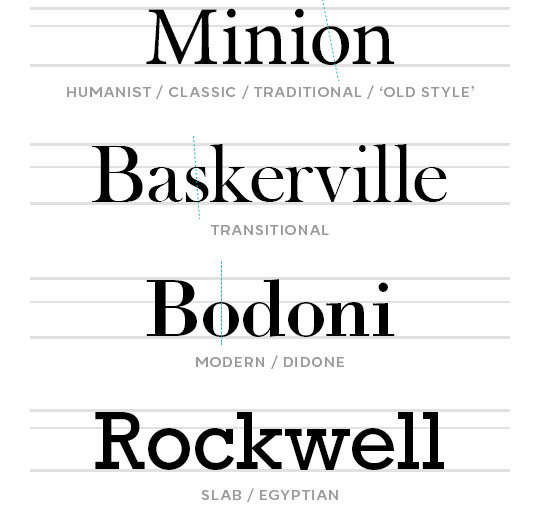
The most immediate difference between these types of serifs is the stroke widths.
If you look at the modern/didone serif Bodoni, the horizontal strokes are hairline thin, and the vertical strokes are very thick. Modern/Didone typefaces are characterized by this extreme contrast in their stroke widths, and typically have a perfectly vertical axis (meaning the narrowest parts of the strokes are at the exact top and bottom of the letterform, as illustrated by the green dotted line). These features give them a bold, modern, and stylish feel.
The humanist serif Minion has the least contrast in its stroke widths, and has a diagonal stress (again, see the green dotted line). These features make them easy on the eyes and well-suited for paragraphs of text and small font sizes. Humanist typefaces most closely resemble calligraphy, and thus have an elegant, classic feel.
Transitional serifs are, well... transitional. They have more stroke width contrast than humanist serifs, but not quite enough to be considered modern/didone, and may or may not have an angled stress. Their ‘voice’ is more neutral, academic, and timeless.
Slabs Serifs, as the name suggests, are kinda blocky. The stroke widths are generally very solid and consistent, and the actual serifs (or ‘feet’) are... y’know. Fat blocks. It makes these typefaces feel more casual, more down-to-earth, approachable, and perhaps playful? A lil rebellious, even?
So with that out of the way, here are some different types of Sans Serifs: (There’s a point to all of this, I swear.)
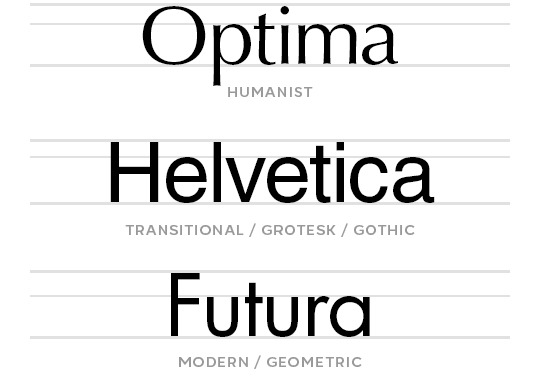
Unlike Humanist Serifs, Humanist Sans Serifs actually have the most contrast in their stroke widths. In the above image, this is most apparent on the lowercase ‘a’. Again, this feature makes humanist sans serifs easy on the eyes and optimal for paragraphs of text. Compared to other sans serifs, they tend to have a more casual and approachable personality.
Transitional Sans Serifs will have little to no stroke width contrast. They maintain their readability at small sizes, and their ‘voice’ is very neutral, which makes them easy to use in a wide variety of designs. There’s a reason Helvetica is the go-to for many a graphic designer: it, along with many other Grotesks/Gothics, almost never feels out of place. They’re the chameleons of fonts. They’re versatile. Invisible. Carbon-neutral.
Geometric Sans Serifs, as the name suggests, are typefaces whose letterforms are based on geometry. O's and C's that are (mostly) perfectly circular, V's, W's and M's with sharp, consistent angles. They generally have very consistent stroke widths, but the harsh angles make them poorly suited to paragraphs of text. They feel modern, technical, and stylish.
4. CHOOSING THE RIGHT FONT
(We are now arriving at the point.)
Here are some questions to ask yourself before choosing a font:
How much text do I have?
If you have a lot of text, you’ll want something that’s easy on the eyes for reading. Aim for things with mild stroke contrasts and favor things with a diagonal axis. Basically, you can’t go wrong with a humanist typeface here-- be it serif or sans serif.
Now, for graphics and gifs, you’ll probably have a lot of text almost... never. But if you’re ever designing something that does (like a magazine spread, or a brochure), it’s something to consider.
How much space do I have?
Let’s say you’re giffing a scene and you gotta cram a long caption onto a tiny 278px wide gif. You could just make the font size super tiny, sure. OR, you could look for a font with a narrow character width. A nice, robust type family will usually include Condensed or even Super and Ultra Condensed versions of the font, which will be much better suited to that purpose.
In these cases, you’ll probably want to avoid geometric sans serifs since those circular forms are very wide, relatively speaking. But some geometric type families (such as Futura) do have Condensed varieties:

How large or small does the text need to be? (or do I want it to be?)
When your text is large, you can kinda go nuts and do whatever without worrying about anything getting hard to read. But there are two things to consider when you’re using a small font size, be it out of necessity or For the Aesthetique™--
stroke width contrast: At small font sizes, typefaces with consistent stroke widths are going to maintain their readability best-- so steer clear of Modern/Didone serifs, and tread carefully around Transitional Serifs. If you’re itching to use a Serif, you’ll want to look for a humanist/traditional/old style one. If you’re super attached to a modern/didone serif for a design (as I often am) understand you’re gonna have to compromise a bit and use a larger font size for it.
For sans serifs, both Transitional and Modern types will have nice, solid strokes that won’t get lost at small sizes.
x-height: A typeface's x-height refers literally to the height of the lowercase 'x'. But in more practical terms, it's the ratio of the heights of lowercase vs uppercase letters. If you plan on using all caps, this won't matter much (if at all), but if you will be using lowercase letters, a typeface with a more generous x-height will be easier to read at small sizes than a typeface with a small one.
Generally, Transitional/Grotesk/Gothic Sans-serifs will have the most generous x-heights (for example, see Helvetica). But x-heights vary a lot even within subcategories of typefaces, so be mindful of them!
Speaking of all these metrics... one of the things that makes the Premium version of FontBase well worth my $3 a month? The Super Search feature:

I can just... highlight segments of those histogram chart things on the right to filter out fonts that don’t have the contrast, weight, character width, or x-height I’m looking for. Like magic. #blessed
What ‘voice’ do I want to project?
I mentioned earlier how different styles of typefaces have different ‘personalities’. If you’re not sure whether to go with a Humanist or a Transitional Serif, remember that humanist ones tend to feel more elegant, more classic, more intimate. That Transitional ones tend to feel more objective, more confident, more business-like. Which makes more sense for your design?
After you’ve narrowed down your options with the above considerations, then you can start to be really subjective. Follow your heart. Pick whichever one has that certain je ne sais quoi. Or the one that has the ‘Q’ with the coolest tail. The one that just makes you feel a certain kinda way. Because it’s art. It’s design. Have fun with it.
5. SOME OF MY PERSONAL FAVORITE FONTS
So... my taste in typefaces is pretty conservative. I don’t really use handwriting, script, or display fonts. When I do, I tend to use them just the one (1) time and forget about their existence immediately afterward. ¯\_(ツ)_/¯
Most of these are tried and true Classics you may have already heard of, and some of them might even be default fonts bundled with your operating system. If not, be very careful looking for them, because it would be a terrible, horrible shame if you were to get your hands on one of the many freely available bootlegs of some of these typefaces... :/
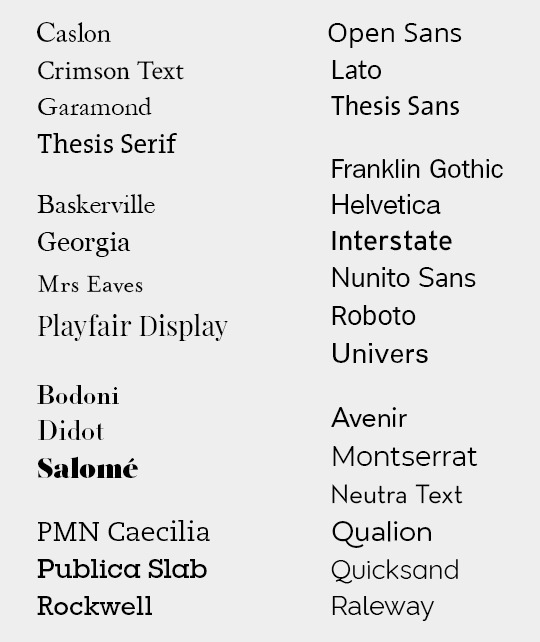
With all these lined up together, you can get a better sense of how varied the x-heights can be from one typeface to another. For a particularly stark example, see Mrs Eaves vs Playfair Display, or Montserrat vs Neutra Text.
SooOoOoOoo... that’s a wrap? I guess?
Congratulations 🎉 you now know way more than I’m guessing you wanted to about typography.
120 notes
·
View notes
Text
64 Best Free WordPress Blog Themes for 2020
Are you looking for a free WordPress blog theme for your website?
There are thousands of free blog themes for WordPress, making it hard for beginners to choose between all the different options. The best WordPress themes can be tough to find. Your free theme needs to be reliable and easily customizable.
In this article, we have hand-picked some of the best free WordPress blog themes that you can use on your site.
Getting Started with WordPress
First, you need to make sure that you are using the best blogging platform.
Self-hosted WordPress.org is the perfect platform to start your blog because it gives you lots of freedom, flexibility, and control. We have a useful guide on the difference between WordPress.org and WordPress.com.
WordPress.org is open source. It comes with support for thousands of free templates (called themes) and extensions (called plugins) that help you grow your blog faster. Take a look at our article on why you should use WordPress to learn more.
You can use our step by step beginner’s guide on how to start a WordPress blog for full instructions on getting started.
Although many WordPress themes are free, you will need to pay for a domain name for your site. This is your site’s address on the internet.
You’ll also need WordPress web hosting. This is where your site is built online.
The great news is that WPBeginner readers can get a fantastic deal with Bluehost, one of just 3 hosts officially recommended by WordPress.
Bluehost offers a free domain name, a free SSL certificate, and a 65% discount on web hosting. Simply go through our link to Bluehost and you’ll get this deal automatically.
Once you are up and running, it’s time to pick a theme for your website. There are lots of excellent premium themes out there. However, there are also some great free themes that will help you minimize the cost of building a WordPress website.
You can choose a theme from our expert selection below and then follow the instructions in our how to install a WordPress theme guide to set it up properly.
Let’s take a look at some of the best free WordPress themes that you can install on your site.
1. Astra
Astra is a fully customizable and free WordPress blog theme. It includes starter sites that are suitable for personal blogs, portfolios, business blogs, and even eCommerce websites. It’s responsive and works perfectly with all the best page builders out there.
It comes with built-in support for WooCommerce to easily add an online store to your blog if needed. It’s also translation-ready and can be used to make blogs in any language.
Astra is a lightweight theme with tons of colors options and fonts. You can find the theme options in the WordPress live customizer.
2. OceanWP
OceanWP is one of the most popular free WordPress themes. It includes lots of features that you normally only see in premium themes.
OceanWP can be used for any kind of website, including blogs, magazines, business websites, or eCommerce stores.
It includes multiple layout choices, fullwidth pages, 2 navigation menus on the top, custom logo support, multiple sidebar areas, beautiful image galleries, and more. It is super flexible but still very easy to set up. It also has live customizer support.
3. Hestia
Hestia is a highly flexible and responsive theme for all types of websites. It comes with an easy setup wizard and a companion plugin which adds testimonials and services sections to your website.
It can be used with popular page builder plugins and is ready for WooCommerce out of the box. The homepage can be easily set up using the live theme customizer. You can just add sections and rearrange them with drag and drop.
4. Bento
Bento is a powerful multipurpose WordPress blog theme with tons of features. It works really well with most page builder plugins and it’s suitable for use as a business theme.
For a free WordPress theme, Bento comes packed with great customization options. All of them can be accessed using the WordPress theme customizer. You won’t need to know any CSS code to get your site looking just the way you want.
5. Go
Go is a blog theme with a minimalist approach to design. It’s a simple WordPress blog theme with a welcome message and call-to-action buttons in the header.
Designed to improve readability, it uses clean typography and handles featured images really well. Also, you can easily add a contact form using any popular contact form plugin.
6. Ribosome
Ribosome is a magazine-style free WordPress blog theme. It comes with a custom header, custom background, and unlimited colors. It has a single navigation menu and a social menu on the top.
Ribosome comes with a 2-column layout with a sidebar on the right. It also has 2 widgets areas at the beginning and end of posts, which are perfect for displaying ads or related posts.
7. SiteOrigin Unwind
SiteOrigin Unwind is a free multipurpose WordPress theme with full WooCommerce support. Designed with a minimalist style, Unwind is highly customizable using the SiteOrigin Page Builder plugin.
It comes with multiple page layouts, custom header, background, and color support.
8. Hemingway
Hemingway is a clean WordPress blog theme featuring a 2-column layout and a full-width header image area with a parallax effect.
It lets you upload your own logo, supports custom widgets, includes page templates, and more. It’s also retina-ready, meaning it’ll look great on high-quality smartphone themes. All the theme options are quick to set up.
9. Neve
Neve is a free WordPress blog theme that works really well for business sites and online stores. It’s also a great option for a personal blog. There’s a navigation menu along the top, with a search bar. You’ll also find built-in social sharing buttons and a featured content slider.
It has a minimalist layout with beautiful colors and typography. You can easily customize Neve. It’s compatible with popular page builder plugins like the Elementor page builder, Divi page builder, and Beaver Builder.
10. Sydney
Sydney is a powerful WordPress theme that’s suitable for both personal blogs and business websites. It gives you a fullscreen slider, plus the option to upload your logo, set your header image, use a sticky navigation menu, and more.
Sydney makes it easy for you to create an engaging front page for your site. It’s also compatible with drag and drop page builders, particularly Elementor.
11. Hueman
Hueman is one of the most popular free WordPress themes. It comes with a multi-column layout and can be easily used on any kind of content-rich blog or magazine-style WordPress website. There’s plenty of space on the front page for showcasing your content.
You also get support for custom headers, 2-column layout, full-width layout, and tons of easy customization options. It’s a fully responsive and mobile-friendly theme, too.
12. Poseidon
Poseidon is a free multipurpose theme. It has a spacious layout, a full-width slider, homepage layout, and multiple page templates.
The homepage layout can be easily set up using widgets. It’s a great theme for blogging and could also work well for a magazine-style website.
13. Maxwell
Maxwell is a minimalistic and elegant WordPress theme. It features a clean magazine-style layout with beautiful typography.
Maxwell also offers various post layouts, the ability to customize colors, and a gorgeous featured posts slideshow.
14. Writee
Writee is a free theme suitable for personal WordPress websites, adventure, and travel blogs. It features a large slider at the top that uses featured images from your blog posts.
It also comes with multiple templates and custom widgets among many other features.
15. Fascinate
Fascinate is a beautiful WordPress blog theme designed specifically for professional writers, freelancers, personal portfolios, lifestyle blogs, and fashion businesses.
It uses beautiful typography, elegant color schemes, and an eye-catching featured slider. It also has custom post types, including video, audio, gallery, and quote formats.
16. Moderne
Moderne is an elegantly crafted WordPress blog theme. It’s designed with readability in mind and puts your content at the center to make it eye-catching. It could be a good option for a magazine-style blog or even a local newspaper website.
It comes with a featured content carousel slider on the homepage and a 2-column layout that shows your content beautifully. You also get lots of customization settings so you can get it to look just how you want.
17. Kent
Kent is a modern WordPress blog theme with a 2-column layout. It comes with a collapsible navigation menu, custom logo, custom background, and header support.
All the theme options are simple to set up using the live WordPress customizer.
18. Lovecraft
Lovecraft is a clean and simple free WordPress blogging theme. It features a full-width custom header at the top and uses bold headlines for post titles.
It comes with a left sidebar and one navigation menu at the top. It also includes special widgets for recent posts and recent comments so you can show the post thumbnail images in your sidebar.
19. Baskerville
Baskerville is a modern and stylish WordPress blog theme. It features a large full-width header image followed by your posts presented as a grid on the front page.
Baskerville comes with gorgeous templates for single posts and pages. It has 4 different page templates and works seamlessly with the WordPress block editor.
20. Admiral
Admiral is a magazine-style WordPress theme suitable for sports blogs, magazines, and news websites. It features a 3-column layout with a sidebar on each side and the content column in the middle.
It comes with a featured posts slideshow, a magazine homepage template, a widgetized header area, 2 different post layouts, and support for infinite scroll.
21. Shapely
Shapely is a great WordPress blog theme with a fullscreen background. It comes in a 1-column layout with several homepage widgets, parallax sections, and call-to-action buttons.
The theme supports popular WordPress plugins that you need to maximize the functionality of your blog. It’s fully optimized for good WordPress SEO.
22. Ashe
Ashe is a beautiful free blog theme for WordPress. It has a magazine-style layout with a large header image and a featured content slider.
It integrates with popular page builders like Beaver Builder, Elementor, and more for easy customization.
23. Hiero
Hiero is a free WordPress blog theme with a magazine layout. It uses bold colors for the header and throughout the whole theme. It features a 2-column layout and has a clear navigation menu on top.
The homepage displays your latest posts with excerpts and featured images.
24. Tracks
Tracks is a thoughtfully designed WordPress blog theme for personal, magazines, and photography websites. It includes a logo uploader, social media icons, search bar, widget-ready areas, and crisp typography.
The homepage features a grid layout of your posts with featured images. Your readers won’t have to do lots of scrolling to find posts they want to read.
25. Mesmerize
Mesmerize is a colorful WordPress blog theme. It is highly flexible and uses over 30 different content sections to showcase your blog content.
It supports video backgrounds, slideshow backgrounds, header content types, and a gradient overlay on the homepage. It’s also WooCommerce ready and works well with WooCommerce plugins.
26. The Columnist
The Columnist is a free WordPress blog theme featuring a magazine-style look. It comes with different layout options for homepage, archives, single pages, bbPress, and BuddyPress.
It also includes a responsive customizable slider and four color schemes.
27. Satori
Satori is a highly customizable WordPress theme for blogs, personal websites, and small business websites. It would look great for a restaurant or a food blog.
Satori features a full-width header on the homepage and comes with different page templates. It also has support for WooCommerce, multiple widget-ready areas, and several post formats.
28. Phlox
Phlox is a highly customizable free WordPress blog theme. It has a beautiful homepage layout with a fullscreen header background image on top and featured content below.
It comes with multiple widget-ready areas, page templates, custom headers, backgrounds, social icons, and color schemes. Plus, it makes it easy for you to comply with GDPR.
29. Illdy
Illdy is a multipurpose WordPress theme suitable for business, personal, and magazine websites.
It is built on the Bootstrap theme framework and features large header images, 2-column and full-width layouts, a custom background, and color selection.
30. Primer
Primer is a simple and clean WordPress blog theme. It features a classic blog layout with a content column and a right sidebar.
It has a fullscreen header image with a custom logo, a navigation menu, and a call-to-action button to redirect users to a landing page on your site.
31. Blog Diary
Blog Diary is a multipurpose WordPress blog theme featuring a beautiful black and white layout. It has unlimited color choices, crisp typography, and custom widgets.
The theme fully supports the Gutenberg block editor out of the box.
32. Garfunkel
Garfunkel is a stylish WordPress blog theme featuring a grid layout on the homepage.
It supports custom headers, custom backgrounds, six post formats (including a gallery slideshow), six custom widgets, a social menu, and 2 page templates.
33. Author
Author is a beautiful WordPress blog theme for authors and writers. It features a simple 2-column layout with a sidebar and navigation menu in the left column and content on the right.
It supports custom colors, backgrounds, and multiple post formats. It is optimized for accessibility and performance.
34. Tempo
Tempo is a modern WordPress blogging theme that can be easily used as a business website as well. It features clean crisp typography with a bright breezy layout.
It gives you lots of customization options. You can change your header, logo, colors, background, and much more. You can also easily add social media links.
35. iFeature
iFeature is a modern and stylish WordPress theme suitable for magazines, business, personal, and portfolio websites. It features a full-width background image and a slider on top followed by your content.
It includes features like sticky headers, author bio boxes, multiple widget areas, and page templates. The theme options can be easily set up using drag and drop in the live customizer.
36. Natural Lite
Natural Lite is a simple blogging theme with earthy tones. It uses large featured images and supports custom headers and backgrounds.
It comes with multi-column layouts and easy customization options. It’s a particularly good option for green or environmental blogs and websites. If that’s important to you, we also recommend checking out our GreenGeeks coupon for eco-friendly WordPress hosting.
37. Responsive
Responsive is a beautiful WordPress theme designed for flexibility. It is suitable for authors, personal websites, photography, and even business websites.
It comes with 9 page templates, 11 widget areas, 6 template layouts, 4 menu positions, and more. Responsive is WooCommerce compatible, multilingual ready, and supports all RTL-languages.
38. Virtue
Virtue is a beautiful and free WordPress blog theme. It has a clean layout with 2 navigation menus and a large full-width header image. It supports wide and full-width blocks in the visual editor, and works with useful blocks plugins.
All the theme options are easy to change using the live theme customizer. Virtue also comes with multiple post formats, including video, gallery, audio, chat, aside, and quotes.
39. Otography
Otography is a classic WordPress free blog theme. It has a large image slider with social icons, navigation menu, and eye-catching colors.
It includes typography options and easy theme setup with drag and drop settings in the live customizer. It’s an ideal theme for personal, blog, magazine, photography, and fashion websites.
40. Ignite
Ignite is a stylish free WordPress theme featuring a classic blog look. It comes with a 2-column layout, plus a compact top bar used for navigation menus, site title, and description.
It uses medium-sized featured images before post titles and uses crisp typography for a better reading experience on your blog.
41. Avant
Avant is a highly customizable and free WordPress theme suitable for all kinds of websites. It is ready for eCommerce with full WooCommerce support and can be easily used to create content-rich websites as well.
It includes 7 header layouts, 5 blog layouts, 3 footer layouts, unlimited color choices, and lots more settings all built into the WordPress customizer. It is tested to work with all popular page builders and other essential WordPress plugins.
42. Responsive Mobile
As the name suggests, Responsive Mobile is a WordPress theme designed with a mobile-first approach. It looks equally great on all mobile devices, computers, and screen sizes.
This theme features 9 page templates, meaning you can easily create great-looking pages with a responsive layout. There are also 11 widget areas, 6 template layouts, 4 menu positions, plus a call-out section with a call to action button. It’s very easy to use and can be quickly set up. It’s a good choice for business websites.
43. Vogue
Vogue is a stylish WordPress theme designed specifically for fashion, lifestyle, and eCommerce websites. It comes with full WooCommerce support and allows you to set up an online store easily.
It offers multiple header layouts, custom WooCommerce design, multiple footer layouts, multiple blog layouts, and lots of extra layout customization. It has unlimited color settings within the WordPress customizer.
44. Magbook
Magbook is a beautifully designed WordPress theme for content-rich websites, including magazines, newspapers, blogs, and more. It features a clean minimalist design with multiple layout choices and a quick 1-click demo installer.
It comes with ready-to-use templates for contact us, gallery, and magazine pages. Magbook can also be used to create an online store or a multilingual WordPress site. It’s tested with all popular WordPress plugins.
45. Panoramic
Panoramic is another excellent free WordPress theme suitable for all kinds of blogs, websites, and online stores. It comes with flexible customization options and a beautiful homepage slider.
Panoramic is very easy to use even for absolute beginners. You can find the theme options in the live customizer. It also works seamlessly with WPForms, the most popular contact form plugin.
46. Conica
Conica is a super-flexible WordPress multipurpose theme that can be used to build almost any kind of website. It’s a particularly good option for an eCommerce site or another money-making website.
It includes 2 site layouts, 2 color schemes, 4 header layouts, 5 blog layouts, 3 footer layouts, multiple page templates, and a bunch of theme options to customize your colors and layouts.
47. CityLogic
CityLogic is a premium-like free WordPress theme suitable for all kinds of sites, including small business websites. It features a modern design with a large header on the homepage, a transparent navigation menu, a welcome message, and your most important content.
It also comes with a built-in slider and can be used with other slide plugins as well. It is WooCommerce ready and can be used to create beautiful online stores.
48. Agama
Agama is a clean and spacious free WordPress theme suitable for all kind of websites. It is super-flexible and comes with simpler theme options allowing you to quickly set it up.
It is built on Bootstrap with parallax support, responsive design, and a minimalist layout. It is WooCommerce ready and can also be used to create multilingual websites.
49. Fury
Fury is a simple WordPress theme with a minimal design and layout. It works out of the box and has very easy to use theme options. It is built on Bootstrap with responsive design and fast performance.
It includes a sticky header, unlimited colors, a smooth scroll effect, and more. It’s also suitable for use with BuddyPress, which allows you to create your own social network.
50. Ascend
Ascend is a beautiful WordPress multipurpose theme. It fully supports the WordPress block editor plus all popular page builder plugins.
Inside, you will find lots of useful options in the theme customizer. Ascend also includes a transparent header, multiple navigation menus, sidebars, color options, and more.
51. Wisteria
Wisteria is a simple WordPress blog theme with a focus on beautiful typography and content. It comes with a custom background, custom colors, custom header, and a left sidebar.
Wisteria also has a single navigation menu on top and beautiful front page design that shows your posts with custom excerpts and featured images.
52. The Writers Blog
The Writers Blog is a free multipurpose WordPress theme designed specifically for writers, bloggers, journalists, authors, and content-rich blogs. It comes with an image slider that helps your site make a great first impression.
The Writers Blog is easy to set up and allows you to select a color scheme of your choice. It’s a responsive and fully customizable WordPress theme. You could even use it to create an online resume.
53. BlogStart
BlogStart is free to download with a clean and simple layout. It’s a great option if you’re new to blogging and want to get started quickly.
BlogStart lets you display featured posts alongside the navigation menu. It’s optimized for website speed and performance.
54. Creativ
Creativ is a modern free WordPress blog theme. It has a full-width boxed frame layout for the header with an image slider, navigation menu, search bar, and social menu.
This theme features a custom logo in the middle of the header section. It also has blurbs for landing pages on the homepage. Creativ is fully compatible with both the block editor and the classic editor in WordPress.
55. Blogger Era
Blogger Era is a free blog theme for WordPress. It’s a good choice for an online magazine, personal blog, news, or portfolio site. It has an about section for you to add an image and excerpt in the sidebar.
Blogger Era offers a centralized layout to post your content. This theme is fully responsive and translation ready to create a multilingual website.
56. Queens Magazine
Queens Magazine is a user-friendly free WordPress blog theme built for bloggers and online magazines. It has a lot of space for your content. With the 3-column layout, you can display multiple featured posts upfront.
It comes with custom settings for your logo and tagline. The Queens Magazine theme offers multiple sidebars and footers so you have lots of options for your site’s layout.
57. Balanced
Balanced is a clean and responsive WordPress blog theme. It has a custom logo with a full-width header background.
The theme has a 2-column layout with an alternating style for posts. You can use any WordPress widgets in the sidebar. It is SEO optimized and supports WPML for translations.
58. Infinity
Infinity is a minimalist and free blog theme. It has bold colors for borders and the background. It’s well-suited for small businesses, designers, and creative agencies.
The homepage has a navigation menu on top with social icons. It allows you to add a custom logo with a tagline.
59. Interserver
Interserver is a beautiful free mommy blogger theme for WordPress. It is fully customizable with lots of options for blog layout and landing pages.
You can add an image slider and categories on the homepage. Interserver has beautiful colors and design features for your entire blog.
60. Journal
Journal is a stylish free WordPress blog theme for personal journals and all types of bloggers. It has stunning typography and a striking design.
It offers a space to add your short bio on the homepage. Journal is a fully responsive and search engine friendly theme.
61. Bold Photography
Bold Photography is a modern and free blog theme for photographers, writers, and authors. The homepage has a fullscreen background image slider that you can replace with your most popular or featured photos.
It has custom widgets, color choices, parallax sections, and more. Bold Photography has a fast page load time and lazy load images to keep it as fast as possible. You can also use any popular caching plugin with it to speed up your website further.
62. Sparker
Sparker is a lightweight free WordPress blog theme. This theme can also be used to create small business websites and online stores.
Sparker features custom widgets, a beautiful slider section, and a featured post column. It also has space to put advertising such as Google AdSense. It is easy to use and optimized for SEO.
63. Memory
Memory is a trendy free WordPress theme with a youthful vibe. It’s SEO friendly and lightweight, so it won’t impact your WordPress site’s speed.
It’s designed to be easy and straightforward to use, even if you’re new to blogging. It includes a featured image slider, too.
64. EightyDays Lite
EightyDays Lite is a great theme for travel bloggers. It has a modern, clear design to help make your travel photos look great.
It’s also lightweight, fast, and optimized for good WordPress SEO. It will look great on mobiles and computers as it’s a fully responsive WordPress theme. It also has RTL language support.
We hope this list helped you find the best free WordPress blog themes for your website. We also recommend taking a look at our pick of the best free and premium WordPress plugins for your site.
If you liked this article, then please subscribe to our YouTube Channel for WordPress video tutorials. You can also find us on Twitter and Facebook.
The post 64 Best Free WordPress Blog Themes for 2020 appeared first on WPBeginner.
from WPBeginner https://www.wpbeginner.com/showcase/best-free-wordpress-blog-themes/
1 note
·
View note
Text
How I make book covers + tips for you!
Hey people of Earth!
Around this time last year, I mentioned I would have a video up on how I make book covers/cover making tips, and to summarize: I did not do the thing, and this year old script is still sitting in my drafts.
SO, I thought I’d kill two birds with one stone and post a written version of these tips! Going to get straight into this because I imagine this will be rather long!
This post will be divided into 6 parts: finding inspiration, concept art, incorporating elements of design, composition, tools and software, and resources. Feel free to skip around to whatever section interests you most!
***Before we get started, really quick disclaimer. I am in no way a professional cover designer. Cover design is merely something I picked up on my own, and I don’t have any formal education/credentials in graphic design. So of course take my advice with that in mind. These are also just my personal thoughts and opinions. So take everything with a grain of salt!
1. Finding Inspiration

What’s the deal?
A really great way to start out in design
Finding cover designs or designers you admire may help you see what works technically
Helps nail down a style you like
In turn, can help you find your cover design style
What should you do?
Look at covers in your genre!
Whenever I design a cover, I take a scroll through Goodreads to pick up some inspiration in designs I personally love
I also love walking around my bookstore and taking a look at physical copies
Find a cover design you like, and point out the specific reasons you like it
Example:
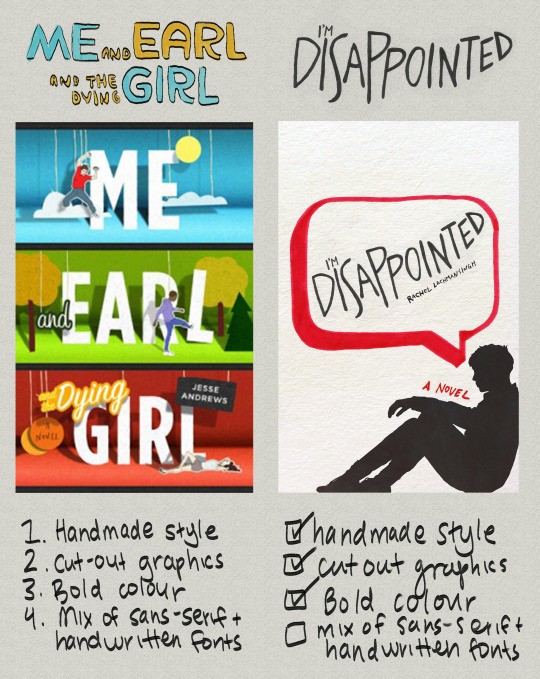
Me and Earl and the Dying Girl was actually not an inspo cover for this edition of I’M DISAPPOINTED, but as you can see, things I liked from it spilled over into my own design. By pointing out aspects of graphic design you like, you’ll better be able to understand your style as a cover artist.
Some personal thoughts:
I like covers that include a textured backgrounds, as seen in the collage below:

So for the I’M DISAPPOINTED cover above, I included a textured background. I also love handwritten fonts/lettering, which I include in almost all of my book covers.
What I did:

Off-white colour from A List of Cages and Holding Up The Universe
Silhouette from Painless and previous cover design of I’m Disappointed
Speech bubble from Simon VS the Homo Sapiens Agenda and Say What You Will
Marker texture from A List of Cages
Obviously my thought process wasn’t to put 4 covers in a blender and thus create my product, ha, this is just an example for the ease of understanding!
2. Concept art

What’s the deal?
Coming up with concept art is a super important part of designing a successful book cover.
Acts as the skeleton of your book cover
Your book cover’s roadmap
Saves time/effort
Similar to an outline for a novel.
Can be a very quick sketch, or full fledged design
I like keeping my concept art quick, but if this is your first cover, making a more detailed mockup can help.
What should you do?
Sketch out book cover ideas once you get them/take notes of concepts you’d like to explore
If you can’t come up with concepts, take a look at your inspiration folder and pull concepts/ideas from covers you love
This does not mean copying another book cover (this is notttt a good idea!). BUT, pulling inspiration from elements you like on a cover can be helpful in generating your own concepts
You don’t have to come up with concept art (sometimes winging it works!) but I do recommend jotting notes down, and drawing out loose sketches when applicable!
Keep a list of ideas for book covers as you accumulate them (almost like a little vault of concepts lol) and reference them in the future!
Take a look at as many book covers as you can and make a list of elements you like and don’t like
This is one of the easiest ways to accumulate ideas/concepts!
Example:
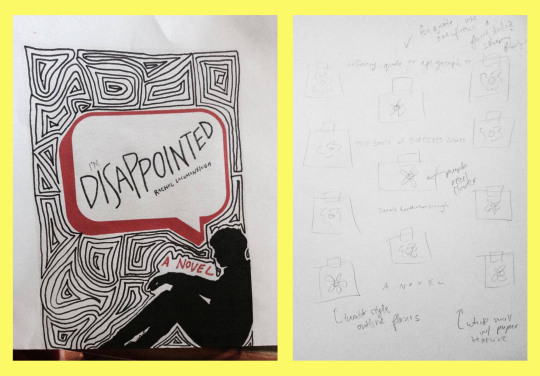
^^^ Concept art for two book covers
Likes and dislikes in book covers:
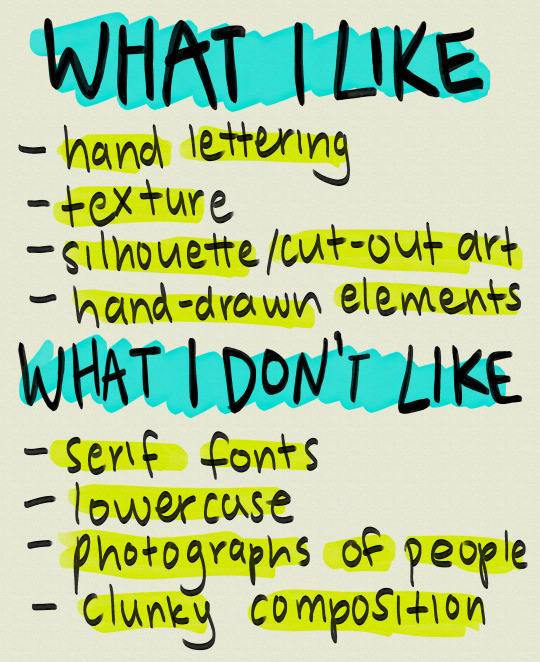
Of course this list is not my be all and end all (nor should it be), and obviously, I still use these things (besides clunky composition I hope!) in some designs!
3. Incorporating the elements of design

What’s the deal?
There are 7 elements of design: line, shape, texture, form, space, value, and colour.
These sometimes vary depending on where you look, but this is what I was taught, so I’m going to be working off that!
Examples:
I’m going to go through them really quickly via an assignment I did for my comm tech class
Keep in mind this assignment is 2 years old and is only meant to give you an idea of what these elements are
1. Line

Line is probably the most important element of design as every piece of art starts with one.
There are various types of lines. You can have curved lines, straight lines, vertical lines, horizontal lines and so on.
2. Shape

You can have more mathematical, geometric shapes, or more abstract, free form shapes.
3. Texture

Texture is the feel of a particular surface.
Texture in my opinion is one of the most important elements when it comes to graphic design, especially book covers.
My favourite thing to see in book covers is texture, whether that be paper textures like construction paper, crumpled paper, wallpaper, lace, wall textures, paint textures, or marker textures
Texture adds depth to designs, and if there’s any element of design you focus on in this post, I’d highly recommend it be this one.
(i’m biased but still)
4. Form

Form is almost like shape, except instead of flat objects, we’re dealing with 3-dimensional objects.
I don’t often use it in my covers since I like drawings and flat shapes in my designs, but if you want to include objects on your cover, or any sort of 3D shape, this would be form.
5. Space

The distance around an object, to put it simply
Space in covers can help emphasize what’s important, and what is less important, or can draw attention to a particular piece of your design.
Examples of space:

Colour coding: yellow = space, teal = focal point/movement of viewer’s eye
In Twilight, the black space helps emphasize the main image, the hands holding the apple.
This also occurs in the Red Queen book covers. The empty space around the crown draws attention immediately to the focal point
You can also lack space. In The Duff, the girl’s face is the only thing you can see on the cover.
6. Value

Is determined by how much light or dark is incorporated into design.
Example of value:

A great example of value in book covers is on Alexandra Bracken’s Passenger. As you can see, the green at the top fades down in a gradient as more white is added to the centre.
7. Colour
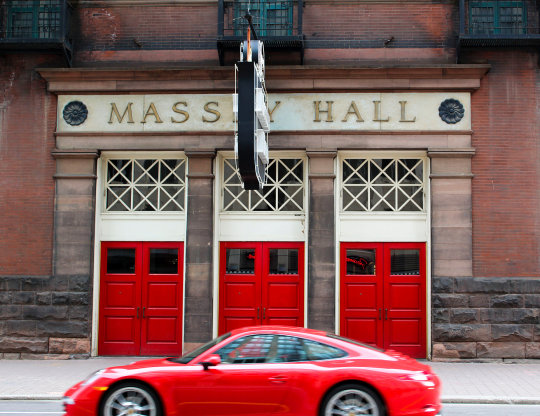
Light reflecting off objects
Can make certain elements of your design stand out
Why should you incorporate the elements of design into your designs?
Adds layers of depth to your work
Thus can take your cover-making skills to another level
Can help in producing ideas
4. Composition:

What’s the deal?
In my opinion, can make or break a design
Can mean clutter of things, OR too much or too little space between elements
Title placement
Composition is sometimes subjective from design to design
What you can do:
Pay close attention to detail and spacing
Look out for natural shapes in your design you can fit elements into
Watch the linked video from Mango Street (one of my favourite photography channels) on composition
While photography and design are two different things, the tips in this video can also be applied to various ideas in design such as headroom and leading lines
youtube
Examples:
*Before I get into this, I want to make it clear that these examples are exaggerations for the purpose of showing you good and bad composition. If you make these mistakes, that doesn’t mean your design is bad, and again, I’m no professional. This comes from what I believe could be considered bad composition, but trust your gut.
Example 1: Stick People
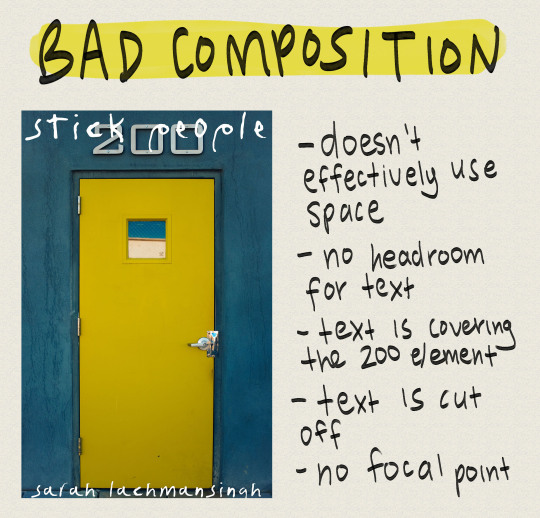
doesn’t effectively use space
no headroom for text
text is covering 200 element (looks very clunky)
text is cut off
No focal point
Can’t read the title
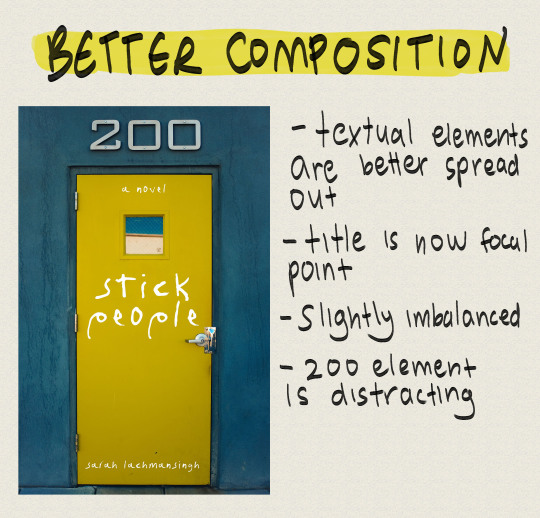
Textual elements are better spread out
Title is now focal point
Slightly imbalanced
200 element is distracting
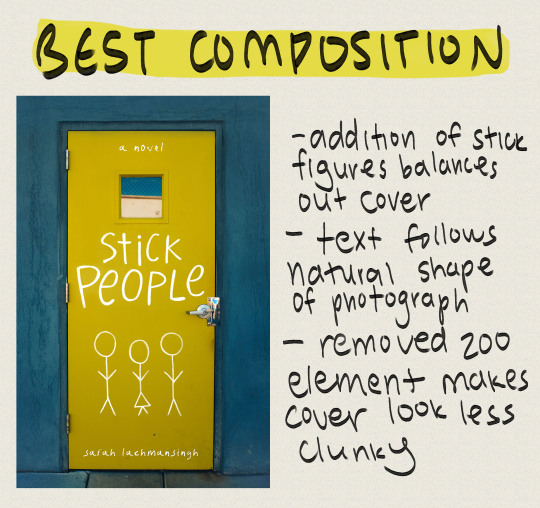
Addition of stick figures balances out cover
Text follows natural shape of photograph
Removed 200 element makes cover look less clunky
Example 2: Sixteen Cents
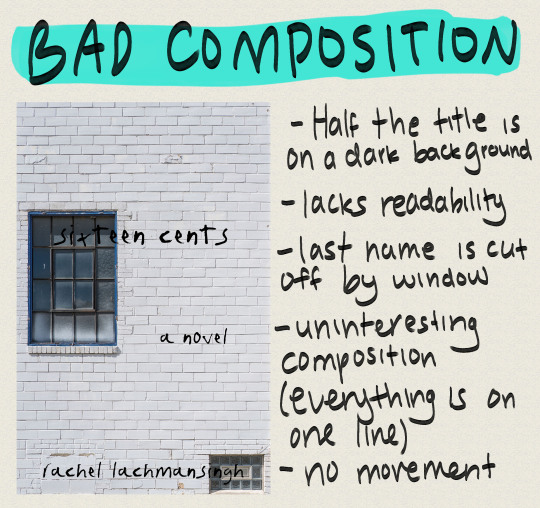
Half the title is on a dark background
Lacks readability
Last name is cut off by window
Uninteresting composition (everything is on one line)
No movement
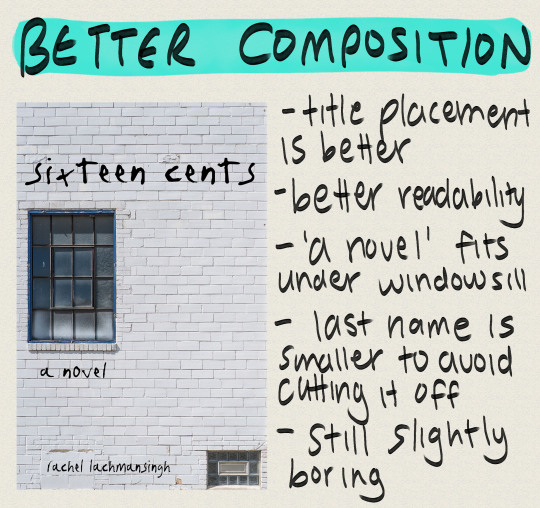
Title placement is better
Better readability
‘A novel’ fits under windowsill
Last name is smaller to avoid cutting it off
Still slightly boring
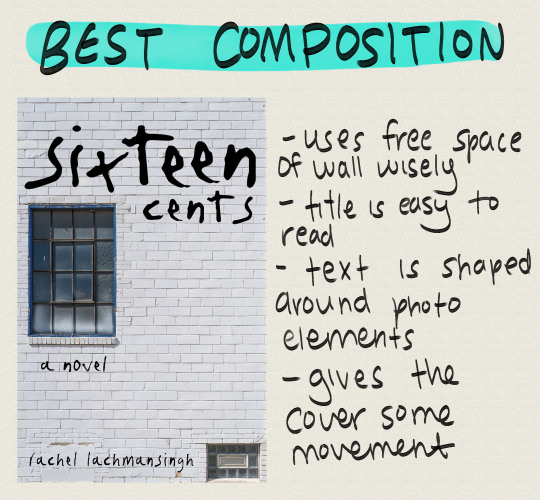
Uses free space of wall wisely
Title is easy to read
Text is shaped around photo elements
Gives the cover some movement
Example 3: Fostered
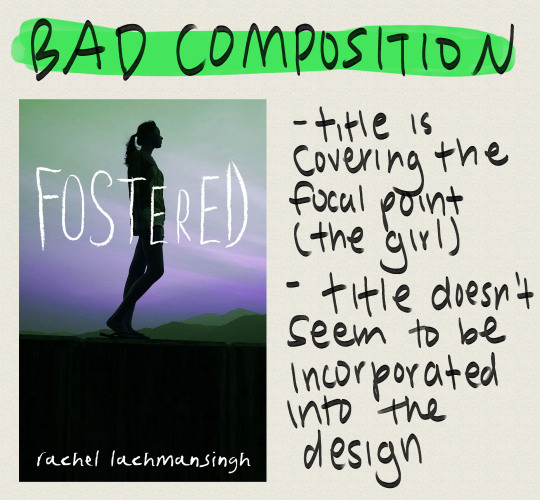
Title is covering the focal point (the girl)
Title doesn’t seem to be incorporated into the design

By moving title down, we’ve made space for the subject
Title placement makes cover look less clunky
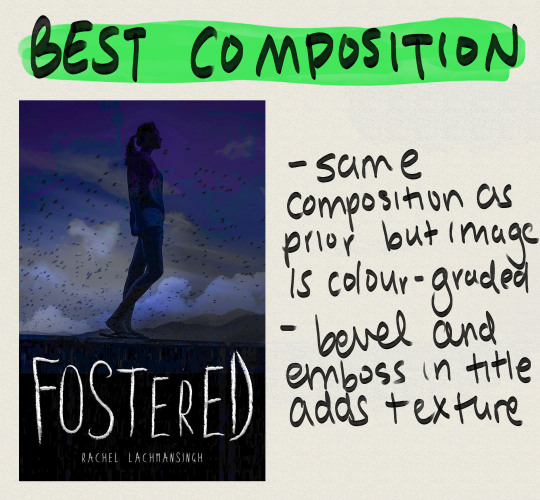
Same composition as prior but image is colour-graded
Embossed title adds texture/depth
I’ve mentioned this a few times in this post: focal point. What is it?
FOCAL POINT:
Is defined as the main attraction of your book cover
This is where you want your readers’ eyes to focus
Focal points can sometimes define themselves in areas where more contrast happens to be
Doesn’t have to be the centre of the page.
Keep focal point in mind for composition because if you put it in the wrong spot, you could end up drawing your readers’ attention to the wrong area of the cover.
The point of most interest in a cover is the focal point, so if you want a particular subject of your book cover, such as a person, to stand out make sure you don’t make the other areas of the cover too high contrast or busy.
Framing subjects also helps, so be creative!
The human eye tends to focus on areas with increased contrast so keep this in mind
Examples:
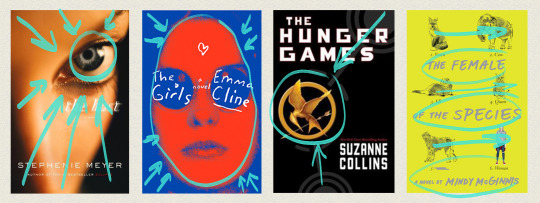
The Host
The camera has focused on the eye of the model, with the nose bridge and forehead shadowing each corner of the cover
Helps lead eye to focal point (the eye)
The Girls
Blue around the edges encircles the focal point (the girl), leading the viewer’s eye directly to her
Girl is also scarlet in colour, contrasting the background
The Hunger Games
Grey outlines on the cover lead straight to the mockingjay
Mockingjay is bright gold in comparison to the black background
Creates contrast, thus viewer’s eye is lead there
The Female of the Species
‘Straight’ composition
No particular focal point, viewer’s eye instead moves horizontally across the design
What should you do?
Use the natural shapes and outlines in your design/photo to fill your cover
Use your space wisely (see examples above)
Use leading lines to draw attention to your focal point
Manipulate text to fill empty spaces
5. Tools and software

You do not need Photoshop to make a good book cover
I made my first book covers in GIMP, a free image manipulation program (kinda like Photoshop’s little brother)
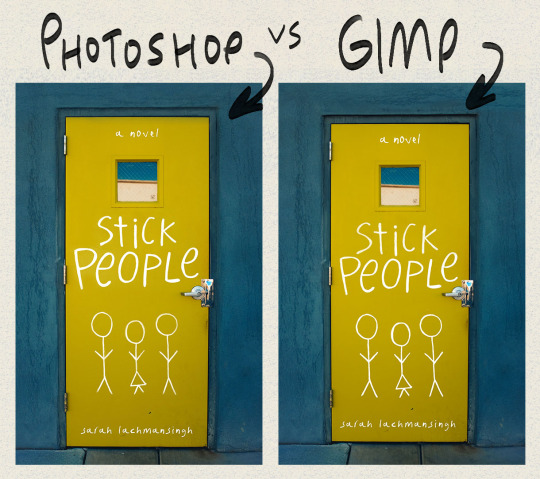
This is the stick people cover I made in photoshop, and the same cover made in GIMP.
Other tools you may want to use are CreateSpace’s cover templates.
You can find these through CreateSpace OR Bookow (my personal fave)
OPTIONAL (what I use):
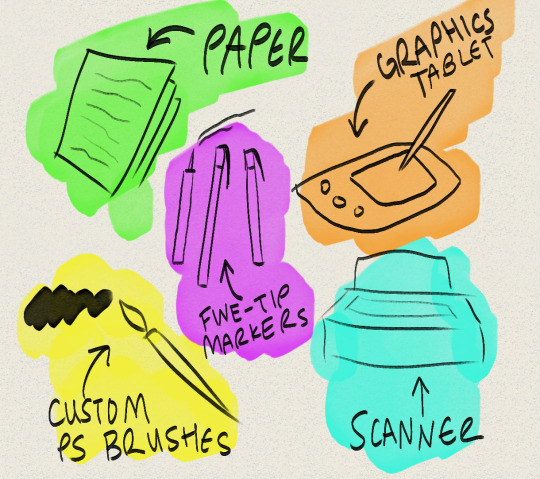
Graphics tablet
I use the Huion H610 which I really enjoy!
I use this to hand letter, draw silhouettes, create concept art, and so on
Paper and my Faber Castell India Ink Artist Pens.
These are fine tip markers, and are what I used to create the text on I’m Disappointed
Thin sharpies and pens will also do the job, and you can always clean any mistakes up in photoshop or gimp.
A scanner so I can transfer what I’ve hand drawn onto my computer
If you don’t have a scanner you can take a clear photograph on a camera or phone
I also use a few custom marker brushes that now come with the 2018 version of Photoshop
The main one I use is Kyle’s AM - Watercolour Paper from the art markers set (you have to load these into Photoshop, but if you have PS 2018, you should have access to ‘em).
(I’ve lettered everything in this post with that brush)
6. Resources

Here’s a list of amazing resources you might need when making your own book covers!
1. Stock image websites
Check out THIS post for a master list of my favourite stock photo websites!
Stocksnap.io
Unsplash.com
Pixabay.com
2. Dafont
Is my main source for finding fonts
3. Goodreads
A huge resource I use to find cover inspiration
I’ll often browse the new releases section to look at new covers and so on
Easy way to narrow down the genre of cover you’re looking for, as well as the age category
4. Keyboard shortcuts
Check out a masterlist for Photoshop HERE
GIMP masterlist HERE
Makes workflow super efficient
My fave I highly recommend in Photoshop is ctrl > shift > alt > e (merge all layers into new layer)
I’ve made TWO custom shortcuts: ctrl > shift > o is now open as layer, and ctrl > shift > alt > r is now rasterize layer (these save so much time!)
So to conclude this post, I’m going to list out some of my favourite tips when it comes to cover making (sort of a reiteration of this post)
Add texture!
Texture is a super easy way to add dimension to your book cover
Try lettering with a paper and marker when starting out
I find this a lot easier than digital lettering!
Google is your friendddd
If you can’t figure out how to do something in Photoshop or GIMP, the internet is a vast depository of information!
Pay attention to detail
Cover design is alllll about the small details. Making sure you’ve centred something properly can seriously help in making your cover go from amateur to whoaaa who made thatttt
Get a second opinion
Been looking at your screen for 8 hours straight? Ask someone you know what they think of your design! I find this has sparked a lot of secondhand ideas!
If it doesn't work out, doesn't mean it was a fail
If a particular concept just doesn’t work, don’t worry! As you practice you’ll get better, and you can always revisit the concept for another novel!
EDIT: a really great suggestion from @sarahkelsiwrites: print out your design if you need a fresh perspective! You’d be surprised by what you notice on screen VS off!
So that’s it for this post! I hope this was helpful for some of you guys, I know it was looooong overdue. If it helped you out, let me know, and if you have any questions, feel free to send ‘em my way! :))
--Rachel
13K notes
·
View notes
Photo
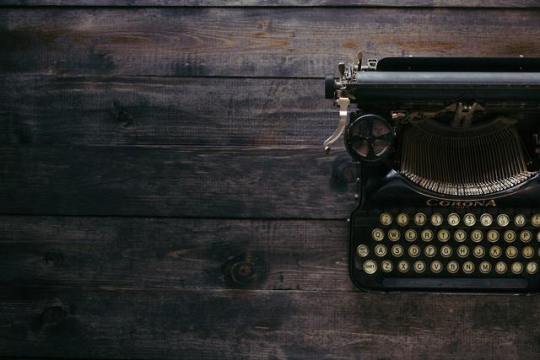
The Novel Writing Process (Indie Publishing Route)
1.) Research the Market
Before you begin, figure out what genre you would like to write in. Horror? Fantasy? Mystery? Romance? Comedy? There are tons of genres, sub-genres, and mixed genres to choose from.
When you have a genre chosen, start reading. Reading is crucial to becoming a good writer. Read what’s hot in your genre right now, study the tropes people like and dislike, and what traits make characters interesting.
By no means am I saying be a copycat. Don’t just write a book about evil spirits rising from an old Native American burial ground because of Pet Semetary’s success and expect fans of horror to enjoy your series. Be original, but take away from your research the “feel” of the books you read. It’s not specifically about what happened in the book, but ask yourself why those events left you craving more and turning the page.
2.) Pre-writing
Depending on who you ask, pre-writing has a specific set of steps and clear paradigms for what is and is not part of this stage. And, as with many steps in the writing process, it is all up to interpretation. To me, pre-writing begins before you jot down a single word. It begins with a spark of inspiration, and is comprised of all the brainstorming, character creation, plot notes, and every other idea you have for your book before you really get down to starting on chapter 1 (or wherever you do begin writing your book; personally, I prefer the ending or somewhere in the middle).
3.) Outlining
There are two main schools of thought when it comes to writing: those who fly by the seat of their pants — aptly nicknamed “Pantsers” — and those who sit down and plot out the entire book in shorthand before they begin — the “Plotters”. I myself am an avid fan of plotting, because I find it greatly decreases the instances of writer’s block, but feel free to skip this step if you’d rather just wing it.
When plotting, simply take the ideas you came up with in the pre-writing stage and organize them from A-Z in your story. This could be a series of bullet points, a death-by-PowerPoint storyboard, or you can shorthand your entire story, then flesh out the details when you go back over it. There are also specific flows to the plot to consider. Find an organizational method that works for you, and ask yourself these questions: Who is the protagonist? Who, or what, is the antagonist? Why does the protagonist want to stop them? What allies do they meet, and what challenges do they face along the way?
For an awesome reference guide, research a concept known as “The Hero’s Journey”.
4.) The First Draft
Now the fun part. Write. Just write. Don’t stop to edit, even if you have a mess of misspellings, punctuation errors, and sentences that come across like a drunk toddler hijacked your keyboard/pen. Just get the words onto the page. Pour your bleeding heart and soul out, have a blast doing it, and understand one simple thing:
The first draft sucks.
The first draft is a heaping pile of manure that should never see the light of day. The first draft would crack mirrors if they had eyes to see it. If you dare to try to publish a first draft, as I have seen impatient indie authors online do, you will invoke my wrath, and I will find you, and I will beat you with a frozen swordfish.
Once you have finished pumping a wordgasm into your Google Docs, Word, Scrivener, or whatever writing program file, sit back, relax, finish your coffee/tea/booze, and cry.
Because now comes the part every writer just loves… So. @&$%ing. Much.
5.) The Self-Edit
“Psh, wait, what? I don’t need to edit my novel. The publishing house will do that for me, or I’ll just hire someone to do it.”
You hear that?
That’s the sound of my swordfish, fresh out of the big ass freezer I purchased just to contain it. And it’s ready for a beat down.
If you were to send a first draft to a publisher, you would be laughed at and rejected immediately. If you’re going the indie route, and an editor you hire needs to spend an enormous amount of time rifling through endless errors, you’ll be digging yourself a massive hole of debt trying to pay them for all that extra work.
Trust me: edit the book to the best of your abilities, and your wallet or publisher will thank you for it later. I would also recommend getting the help of friends and family, if available. These people, reading over your book in the first draft stage (and you better buy them a coffee or something), are what are known as “alpha readers”. We’ll go into depth on the types of readers who help in the editing phase in another post.
There are multiple types of edits to do:
Developmental edit
Read over your story and take note of what makes sense or not, what weak areas could be strengthened, and weed out any continuity errors you find. Just focus on the plot and big scenes. Best to get help with this one in the form of beta readers (see next step).
Copy edit
Go word-by-word checking for typos and spelling errors along with correcting grammar, language, and syntax errors. Also, at this point, deal with any punctuation issues you see.
Line edit
Focus on the finer aspects of language. Read over each sentence to asses their flow and whether or not they get the idea across. Try to tighten them up and avoid run-on sentences.
Sensitivity edit
A sensitivity edit it highly recommended when writing about other cultures, minorities, LGBTQ+ characters, and social issues you may not be familiar with. You don’t want readers getting pissed and blasting you for being homophobic, misogynistic, racist, and/or ignorant. This may be difficult to do on your own, so I recommend a fresh set of eyes from a friend or family member to help you, particularly if they happen to be a part of the group you are writing about.
Proofread
This is the final edit. Read through your manuscript one last time to check for any spelling mistakes, grammatical issues, continuity errors, or other glaring problems.
6.) Get Beta Readers
A beta reader is someone who reads your manuscript and gives feedback before it is ready to be published. What defines a beta reader vs. an alpha reader is actually kind of blurry. Personally, I believe beta readers should come after you have done some thorough self-edits. When you get feedback from your betas, apply it to your book, and continue with another round of self-edits.
Whatever you do, get the beta reader feedback BEFORE the professional edit. Obviously, you don’t want to add the feedback into your book after the edits, then have to pay someone to re-edit those parts of the book.
7.) Get a Critique Partner
Got any writer friends? Good. Ask them if they would help you in the self-edit process by reading through your book and giving feedback as a fellow writer, not as a reader. Think of a critique partner as a beta reader who is reading from the author’s perspective. They can have a world of information and writing tips you hadn’t even considered during the first draft.
8.) The Professional Edit
“B-but I already did my own edits!”
Yes! Good job! Here’s a cookie. Chew on it while you send your book off to people who are vastly more experienced than you.
There’s no skipping this step, even if you’re on a tight budget. Your book needs a professional edit in the form of all the edits you just did. Without it, readers will be able to tell it’s an unfinished book, and you’ll come across as an amateur.
I’m not going to lie, if you’re going the indie publishing route, it’s expensive. Get good at saving money from your day job. Some editors charge per hour, some per page, and some per word. A common fee is $0.01 - 0.03 per word. Doesn’t sound intimidating at first glance, but if you’ve just finished 50k words for NaNoWriMo, or you’ve got the next great 120k word urban fantasy that’ll blow the Mortal Instruments out of the water…well, you do the math.
Just, please, for the love of all that is holy, don’t hire some shady “super experienced” all-purpose editor off of Fiverr because you want to save a buck, then wind up getting half-assed work back and need to find a real editor to fix it. Cough… Not that I’d know anyone who did that. <_<
9.) The Book Cover
“Don’t judge a book by it’s cover” is a phrase only to be applied as a metaphor to say “don’t judge people based on their appearance.”
In the book world, we DEFINITELY judge books by their covers.
If you do absolutely no other form of advertising, make sure you have a damn good book cover. The cover is going to count for about 80% of your advertising. You might have a book that’s going to change peoples’ lives and make you a household name along with a buttload of money. But if the cover sucks, no one is going to buy it except for a few family members and friends.
Make sure you research what book cover styles are popular in your genre so it stands out to readers as something they might enjoy. For example: most urban fantasy YA novels feature a model of the main character in the middle, and they might be holding some sort of weapon; the background is neat, perhaps a city scape or a mystical forest; the font of the title and name are custom-made and might have a swirling, curved, or twisted shape to them.
10.) Formatting
This is often a package deal with book cover designers. Get your book formatted for readability on whatever platform you’ll be publishing it to.
11.) Get an ISBN
Submit your book for an ISBN. Easy peasy. Now, if you’re just going to publish on Amazon, they do have their own free ISBN, but if you want to publish to other sources like Kobo and iBooks, you’ll need to get your own.
12.) Publication
This is it. The moment you’ve been waiting for. Once you’ve got your book all together in an awesome package, find which platform you want to publish your book to — Amazon, iBooks, Kobo, Blurb, Lulu, Smashwords, etc... — and follow their guidelines for setting up an account, giving them your tax info, and uploading your files.
Congratulations! You’ve just published a book. Is it your first one? Then revel in the fact that you are now officially an author. Go out and celebrate with a steak night and a beer (or whatever is appealing according to your diet), then get back to work.
13.) Extras
Not mentioned in this process are things like building your author platform, marketing, advertising, getting deals with bookstores and libraries, and setting up book tours. These don’t have a set place in the writing process. When it comes to marketing and building your author platform, those are things you need to do even before you begin writing your book, all throughout the process, and long after it’s all finished. Things like planning when to officially launch your book, and whether or not pre-orders will be available, are important considerations as well.
Every writer has their own process. This has been my personal experience with the indie writing and publishing process. Comment down below if there is anything you would add to help aspiring, brand new, and veteran authors achieve their writing goals. Thanks for reading!
#writer#writing#advice#bibliophile#process#tips#writeblr#publishing#selfpublishing#indie#indiepublishing#amazon#kindle#kobo#ibooks#ebooks#smashwords#lulu#books#reading
5 notes
·
View notes
Text
september reading
i read some things i guess! open for the last (almost) of robin hobb, more mountaineering disasters, and …. dungeons & dragons?? (i completely forgot i had this in my drafts lol)
the nickel boys, colson whitehead
idk man this is really well-written, well-paced, an important story based very much on real history, the characters serve their purpose very well, the violence and abuse is written in a way that is chilling without ever being gratuitous and with the exception of a twist that i thought was a little too predictable, there’s nothing i can really criticise. it just really lacked some spark for me, and maybe it’s just that after underground railroad (which is also didn’t particularly like, but damn that had spark) it feels a lil conventional. still good tho! 3/5
the adventure zone #1: here there be gerblins, various mcelroys & cary pietsch
my brain Does Not Do podcasts but obvi i’ve been hearing A LOT about the mcelroy boys & i’m like. vaguely interested in d&d* so when this was made available on overdrive i was like okay why the hell not. it’s a fun, quick read, and while i don’t really know anything about d&d the trappings of the game were included in a fun way. nothing mindblowing, but a good time. 2.5/5
assassin’s fate (fitz & the fool #3), robin hobb
y’all this is it… it’s been over a year & now i’m done with the realm of the elderlings (actually i still have the piebald prince novella & the short stories). i have some criticisms of this one (the timeline & the main climax seemed a lil muddled to me) but to be honest??? loved this, had all the feelings, was superhappy to see my cursed shores kids again, fitzy & bee were heartbreaking all the time, the paragon conflict was great, when fitz got to the quarry i literally immediately started uglycrying & pretty much didn’t stop until the end, so: 4.5/5 (series rating 4/5 i guess bc fool’s assassin was a drag & a half)
die nebelkrähe, alexander pechmann
this is a speculative fictionalisation of a little episode in the spiritualist movement where medium hester dowden claimed she had communicated with/been briefly possessed by oscar wilde, which is pretty fun. unfortunately, pechmann chose to focus on his version of mr v., a pretty boring mathematician and skeptic, rather than the absolutely wild shit going on with dowden, which includes oscar wilde’s ghost dunking on james joyce (who responded by making fun of the whole thing in finnegans wake) and claiming he’s like totally straight. 2/5
oval, elvia wilk
a neoliberal corporate hell/psychotropics/eco-punk gone wrong dystopia in berlin so you know i’m here (i.e. in berlin lol) for it. this is about a berlin in the not too distant future where finster corp (real subtle) is buying up everything, driving up rents through ecological redevelopment, artists mainly work as consultants for corporations, and our protags anja and louis live in a finster-sponsored zero-waste eco-commune on an artificial mountain in the middle of berlin. everyone’s jobs are nda-clad bullshit, everyone parties all the time without ever enjoying themselves, homelessness and income inequality are ignored with the barest twinge of guilt, and louis is developing a party drug that chemically makes you generous. oh and the nature on the mountain (the berg -.-) seems to be eating itself. the concepts are great, the writing is pretty good even tho it tries a bit too hard sometimes, wilk, while also suffering a lil from Expat Gaze, really knows berlin. the execution isn’t perfect, the pacing is a bit off, too much time is devoted to anja and louis’ boring relationship, and look, some of the dystopian elements are a bit obvious. neoliberalism bad. okay, we know. but there’s a lot of good here, and the ending is pretty great, if a bit underdeveloped. 3.5/5
travelers, helon habila
a novel about the african diaspora in europe, told thru 6 inter-connected stories, all focusing on one story of migration. these are important stories well told, and i liked how they all linked up in the end. while berlin is the central hub these stories revolve around, not all are set in berlin and the setting really isn’t as central as i’d hoped (this is obvi very personal to me & my research interests so it’s not really criticism). i’d recommend this if you’re interested in the representation of african migrants and refugees. 3/5
the uninhabitable earth: life after warming, david wallace-wells
shit’s fucked: the book. starts with ‘it is worse, much worse, than you think��� and doesn’t really get much more cheery from there. good if you want an idea of what the effects of global warming might be (a pretty pessimistic one, which is the point - when does pessimism become realism?), and how we (& how we might) respond to them. 3/5
the girl from the other side, nagabe (#1-5)
spooky-yet-wholesome manga series about a snazzy demon who’s adopted a little human girl who has been abandoned/cast out by her human community, which is like 100% my jam. the central relationship is super cute & wholesome, the demon designs are amazing, the worldbuilding is really spooky & intriguing (if you touch a demon you’ll be cursed & also turn into a demon & tbh who doesn’t want to turn into a weird tall slightly monster with cool horns), and a lot of it is just the demon like. badly baking pie to cheer the girl up.
girl woman other, bernardine evaristo
somewhere between a novel and a collection of short stories written in a somewhat unconventional but highly readable style. the 12 stories each focus on one woman (and one nonbinary person), most of them black, examing black womanhood in britain throughout the 20th and 21st centuries. i enjoyed many of these stories, but the observational style and the way we quickly cover whole lives left me a bit detached. there’s also a lil corniness throughout, which comes out in full force in the epilogue, and while it’s cool to have trans rep, it honestly came across as a bit clueless. 3/5
dark summit: everest’s most controversial season, nick heil
did someone say high-altitude mountaineering disasters? because i’m always here for some high-altitude mountaineering disasters. this is about the 2006 season which was p disastrous in terms of deaths even tho it didn’t even have a storm (cf the 1996 season aka please just read into thin air), just people walking past dudes who were dying bc rescues are extremely difficult & dangerous. anyway this ain’t into thin air, but it’s a good one & pretty wild bc all mountain climbers are fucking nuts. 3.5/5
sense & sensibility, jane austen
really enjoyed this! the pacing is a lil weird & none of the men really is all that, but it’s all very charming & witty & i love sisterhood narratives (poor margaret!). as in (tho not as much as in) mansfield park, there’s a lot of attitudes that just don’t really track but in contrast to mp i found them interesting rather than frustrating, mostly - brandon/marianne is very uncomfortable especially when you realise that he’s projecting his tragic dead first love/sis-in-law onto marianne and that we don’t really see their courtship at all, but w/e. i especially enjoyed the ferrars family drama and the hilarious resolution to it, and i gotta say: lucy steele really did that & good for her. 4/5
anyway, i’m about halfway thru alasdair gray’s lanark, which is a great big pomo brick, half portrait of the artist as a young glaswegian, half weird visions of hell in the city of unthank & i’m into it but it’s not a quick read. in october uni reading is also going to start, perhaps for the last semester ever :(
#the only podcast i ever semi-successfully followed was welcome to nightvale#and only because it was the kind of story where it didn't matter if you spaced out several times in between#and even then i kinda had to stop once they started having an overarching plot#*lmao rereading my lil review for adventure zone where i say i'm vaguely interested in dnd is a trip#after i spent the whole last month mainlining critical role and most of my dreams now involve dice stuff i barely understand#like i really had three separate dreams about dnd last night & i've never played it & know nothing about it that isn't in critical role#really just want to be a tiefling that bad huh#the books i read
1 note
·
View note